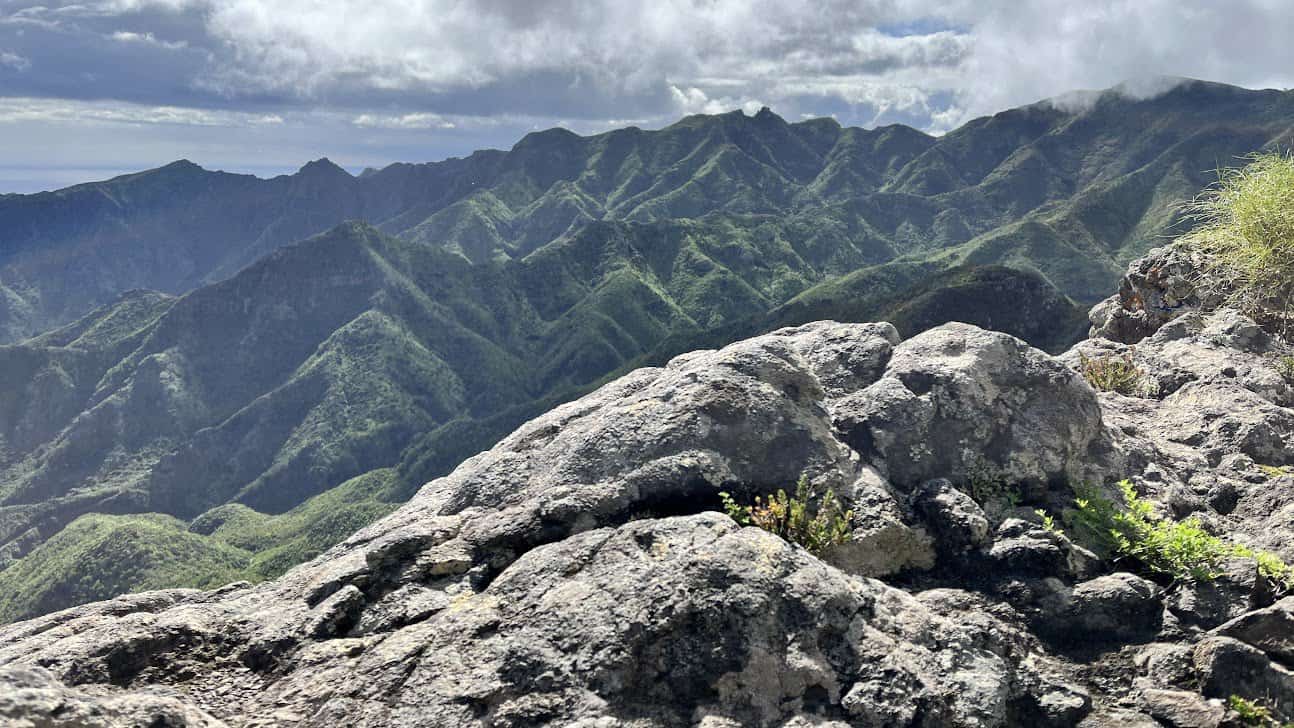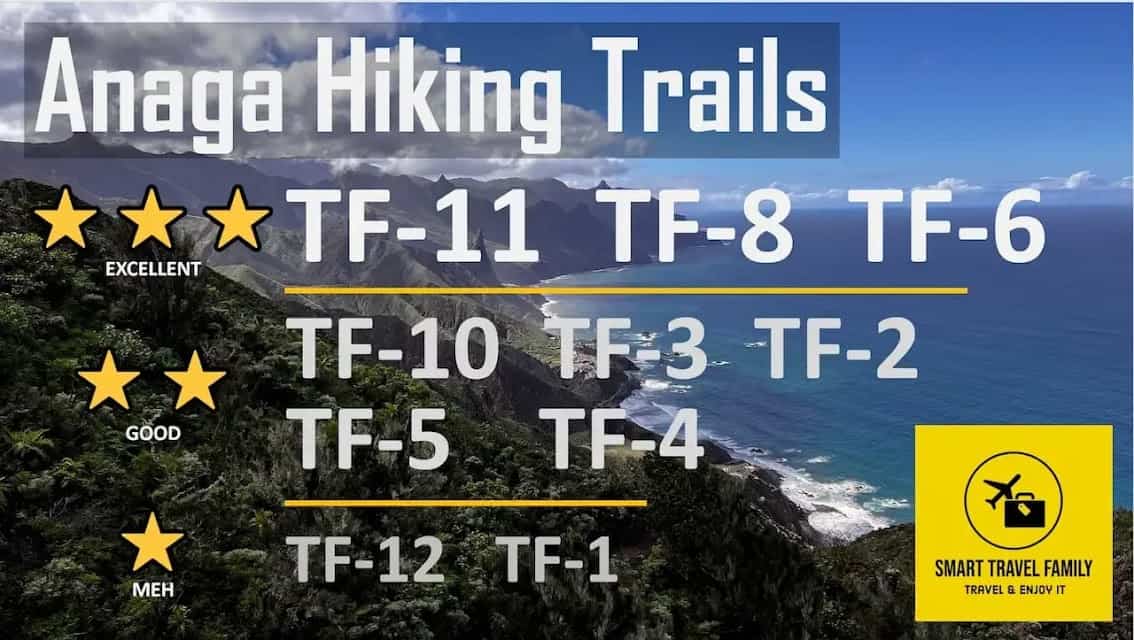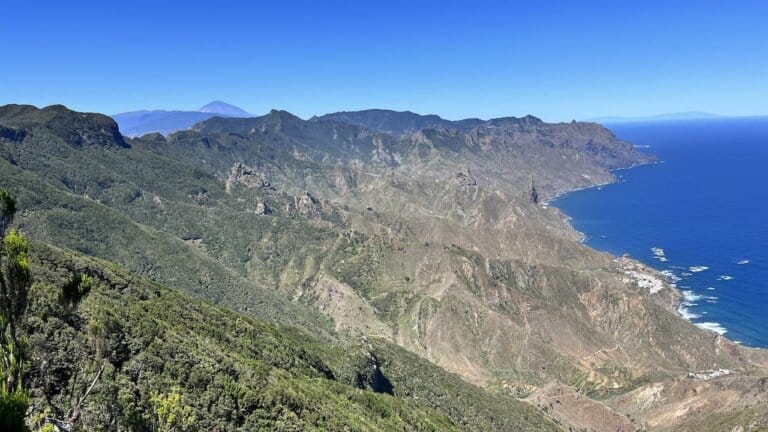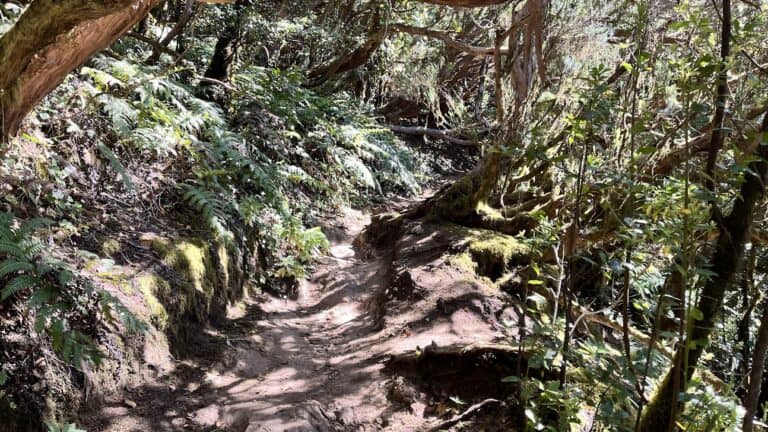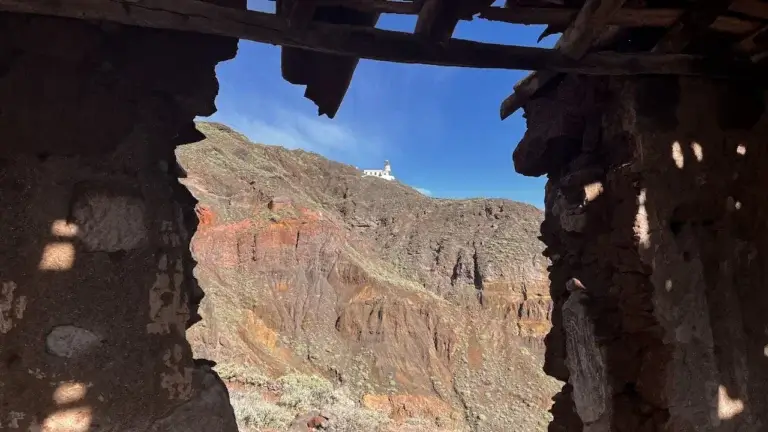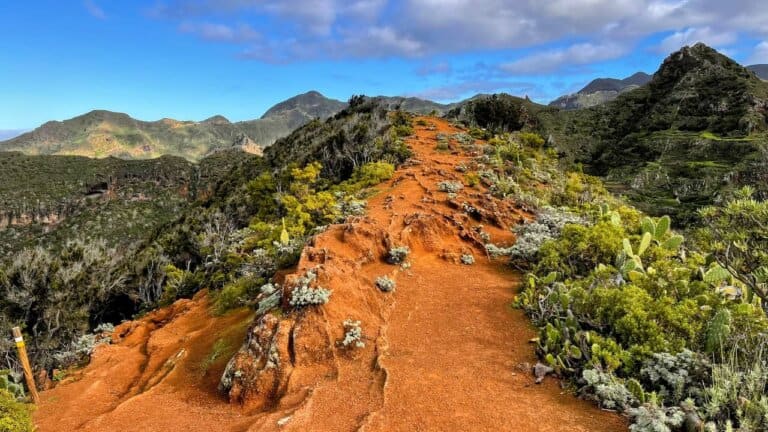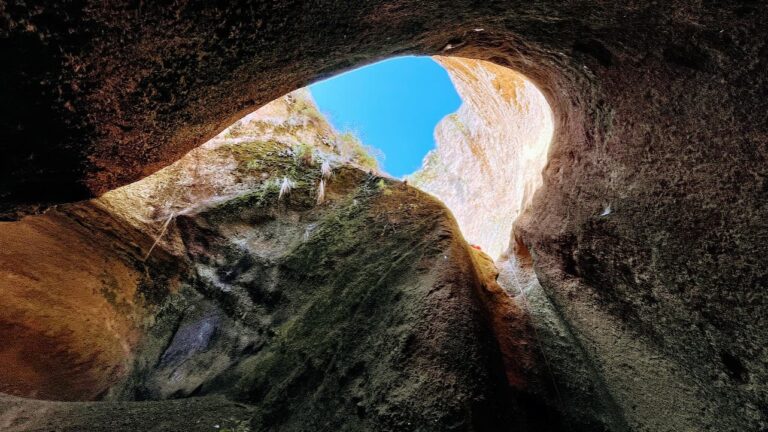TF-5 Chamorga – Igueste San Andres Trail Guide: Possibly the Longest Ridge Walk in Anaga
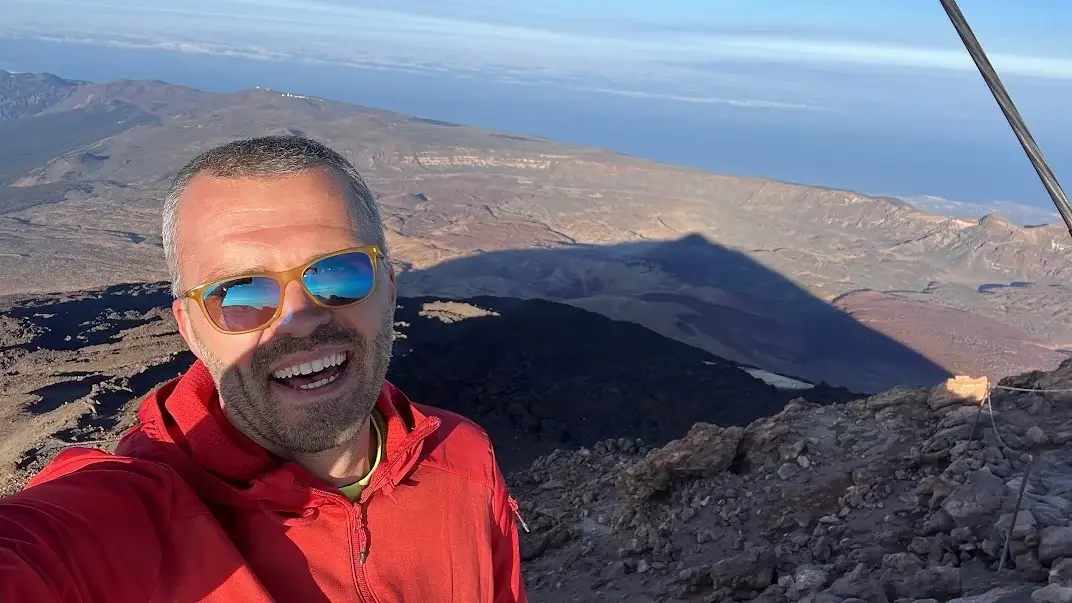
WHY TRUST THIS INFORMATION? I hiked A LOT, including a quest to hike all Anaga trails during my family’s year in Tenerife from 2022 to 2023. This and other articles are based on my personal experience, while hiking alone and with our kids.
TF-5 ‘Business Card’
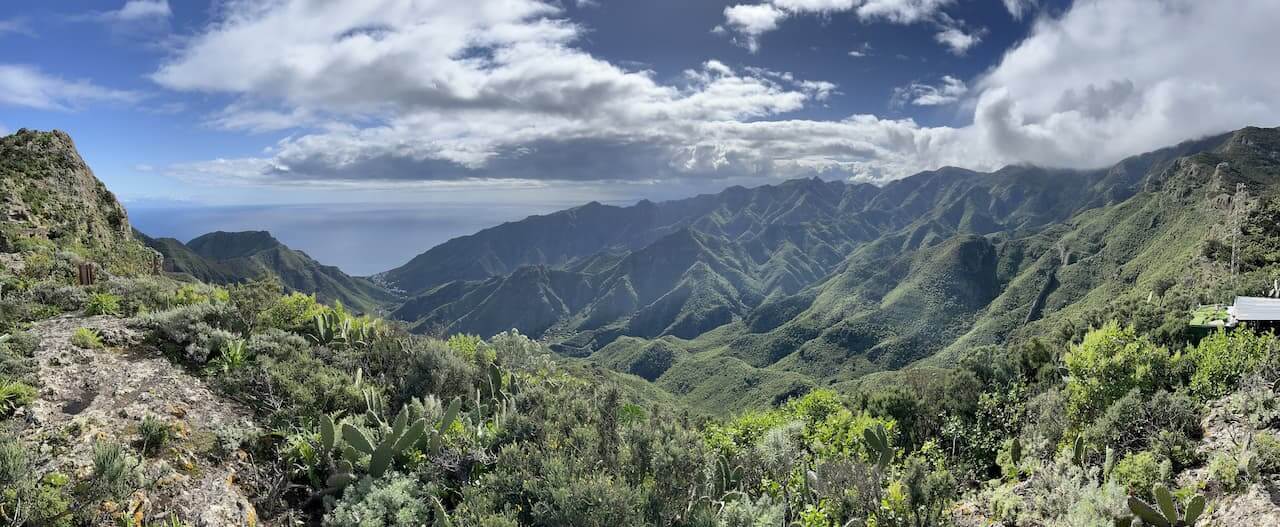
TF-5 has probably the longest ridge walk in all of Anaga Rural Park. And you get to enjoy beautiful panoramas of the Anaga mountains on both sides of the walk. TF-5 is similar to the TF-2 trail that starts in the Taborno village. TF-5 starts in the same location as the TF-6 trail – in Chamorga, the most distant inhabited Anaga village.
TF-5 Ranking Among Other Anaga Hiking Trails
If you do not want to do further research, below is an overview of all Anaga hiking trails ranked from best to not so impressive.

This rating should be useful for the average hiker, travelling without children and not having any health issues or low physical form.
Map of TF-5 trail with variant TF-5.1
The TF-5 trail is marked in red on the above map. It goes from the Chamorga village (trailhead of also the TF-6 trail) to the Igueste de San Andres town.
TF-5 ridge walk – see red dotted line

The above trail length and elevation numbers are based on my GPS watch readings when doing the trail. They may differ from figures in information of the Anaga Rural Park Administration. In general, there was at least a slight discprepancy between official and hikers’ GPS readings for most Anaga trails.
Our TF-5 Hike Video
If you have any questions about this hike, please leave them below or under the video on YouTube, and I’ll try to respond ASAP.
This article describes the trail as done from Chamorga to Igueste San Andres. If you decide to do the trail in the opposite direction, make the necessary planning adjustments and prepare for a harder hike.
Why Is the TF-5 Trail Worth Hiking?
Below is a visual introduction to the TF-5 trail, however, I’ll try to summarize the main rational arguments for doing this hike.
- The main reason to take the TF-5 is the ridge walk in both directions from the Las Casillas settlement. The ridge walk is around 0.6 miles / 1 kilometer long and has very nice views on both sides of the trail. Approximate coordinates of both ends of the ridge walk: 28°33’17.0″N 16°09’32.8″W and 28°32’51.7″N 16°09’09.7″W.
- TF-5 goes through several villages – Chamorga, La Cumbrilla, Los Laureles, Lomo de las Bodegas, Las Casillas, Lomo la Laderita – making the hike also a nice sociological experience.
- Continuing on the cultural theme, the trail goes past the Santa Modesta cemetary. We found it interesting to see the local burial customs during a brief peek inside the cemetary’s walls.
How to Make Sense of Anaga Trails? Which to choose?
There are 12 official trails in the Anaga Rural Park in the North of Tenerife.
These trails are numbered from TF-1 to TF-12 and some have additional sections like TF-6.3 to add variety to your hikes or connect trails or villages with car parking locations and bus stops.
| Trail | Length (miles / km) | Vertical ascent (feet / m) | Difficulty | Additional Information |
|---|---|---|---|---|
| TF-1 | 2.36 / 3.8 | 1014 / 309 | Easy | Child-friendly |
| TF-2 | 7.46 / 12 | 1562 / 476 | Medium | Child-friendly |
| TF-3 | 6.03 / 9.7 | 2133 / 650 | Hard | Circular |
| TF-4 | 2.11 / 3.4 | 66 / 20 | Easy | Child-friendly, downhill trail |
| TF-5 | 6.84 / 11 | 1230 / 375 | Medium | |
| TF-6 | 7.89 / 12.7 | 3044 / 928 | Hard | Circular, top choice |
| TF-7 | 4.77 / 7.68 | 1089 / 332 | Easy | Child-friendly |
| TF-8 | 9.63 / 15.5 | 3353 / 1022 | Hard | Circular, top choice |
| TF-9 | 3.85 / 6.20 | 667 / 203 | Medium | |
| TF-10 | 7.41 / 11.91 | 853 / 260 | Hard | |
| TF-11 | 7.71 / 12.40 | 1292 / 394 | Hard | Top choice |
| TF-12 | 7.12 / 11.45 | 331 / 101 | Easy | Child-friendly, boring |
In all cases, I took the trail from the middle of Anaga Rural Park to the ocean side. The vertical ascent shown in the table is in the direction of the ocean. If you would take any of the trails in the opposite direction, they would be much harder.
The internet is full of Anaga trail suggestions that present a segment of these 12 trails as a unique trail, confusing both novice and experienced hikers.
The table above provides a useful overview of the 12 trails. You should also read our Guide to All Official Routes in the Anaga Rural Park.
Starting Points
Chamorga
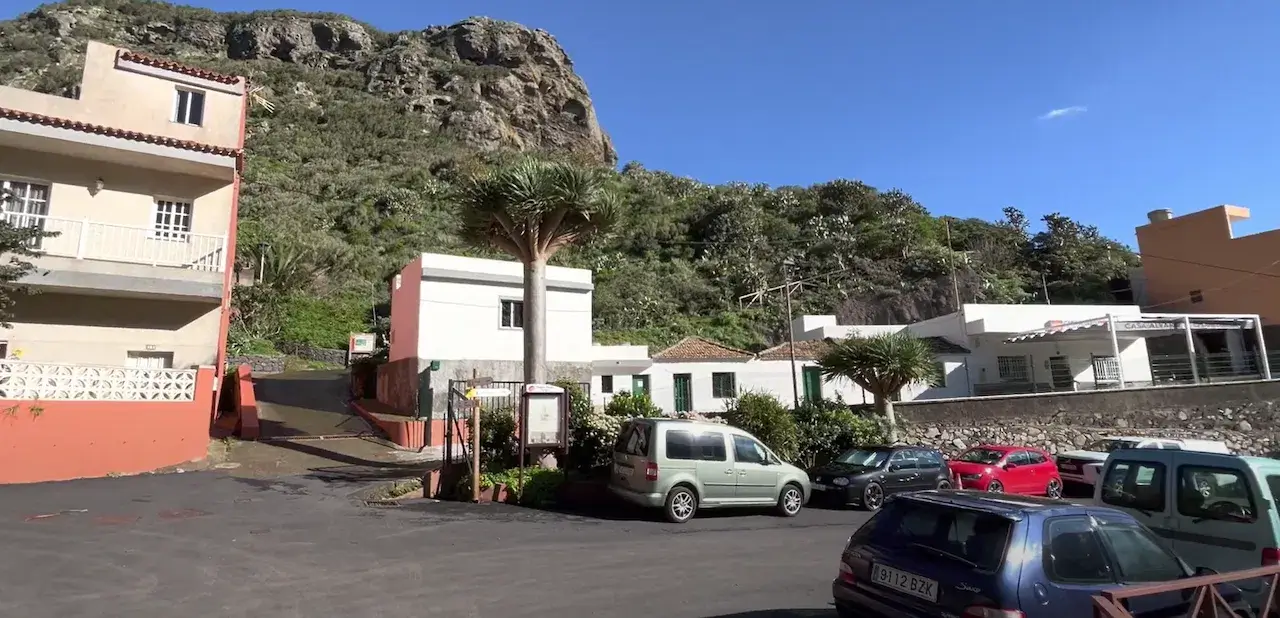
You have to decide how hard of a hike you want, as that will decide your starting point for this hike. For most people we recommend starting in the Chamorga village, and going towards Igueste San Andres and the ocean. A significant benefit of this is that Igueste is served by public transport bus 954 more frequently (8-9 times a day) than Chamorga (Titsa bus 947 3-4 times a day) and you’ll be able to get a ride back to Santa Cruz more easily.
Igueste San Andres
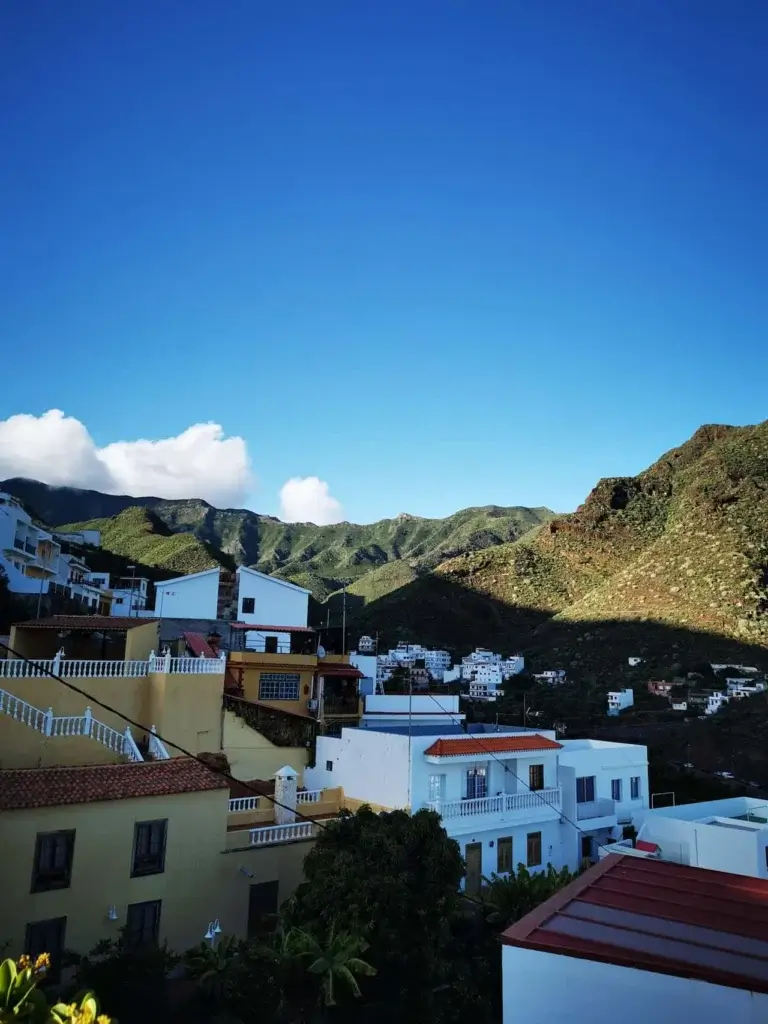
However, if you want to do some quite serious exercise, you can also go the opposite way from Igueste to Chamorga. If you judge a trail by vertical ascent feet / meters, going this way will make the trail roughly three times harder.
Visual TF-5 Trail Guide and Key Landmarks
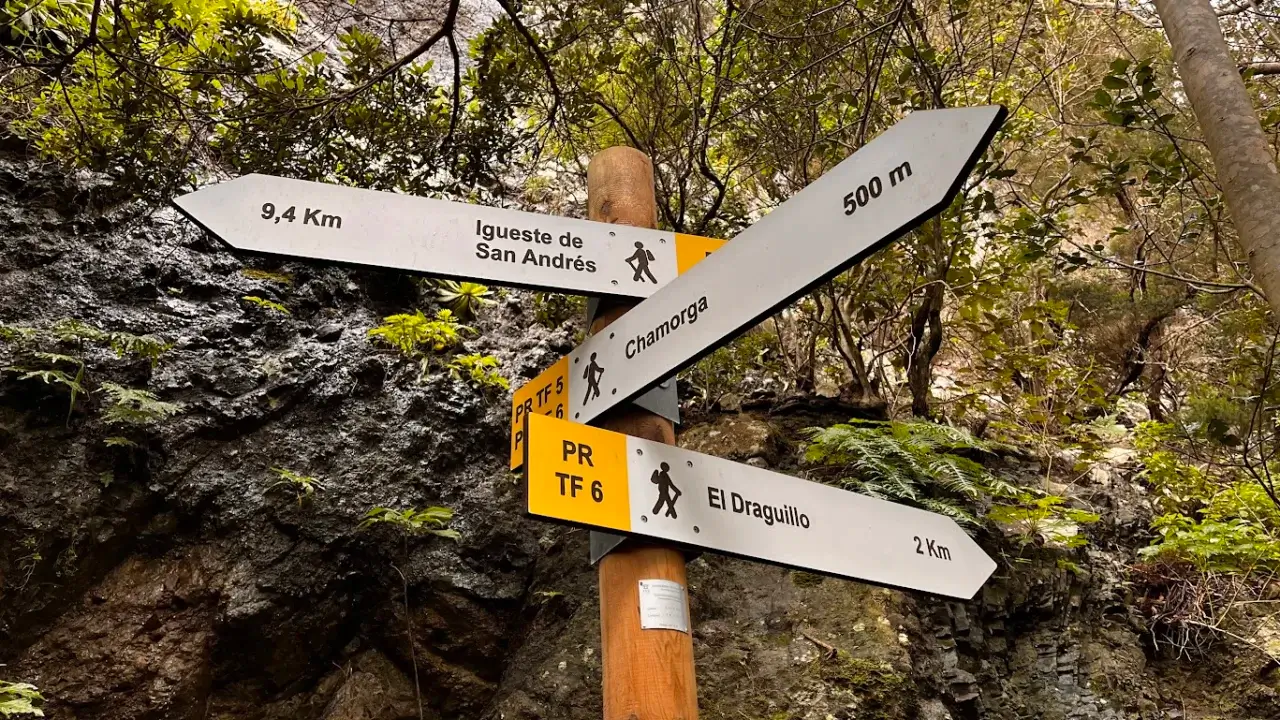
We suggest you start the TF-5 trail in the Chamorga village. This trail coincides with the TF-6 trail in the direction of El Draguillo village for the first roughly 600 yards / 500 meters, but then forks off. The trail split has a clear sign marking it.
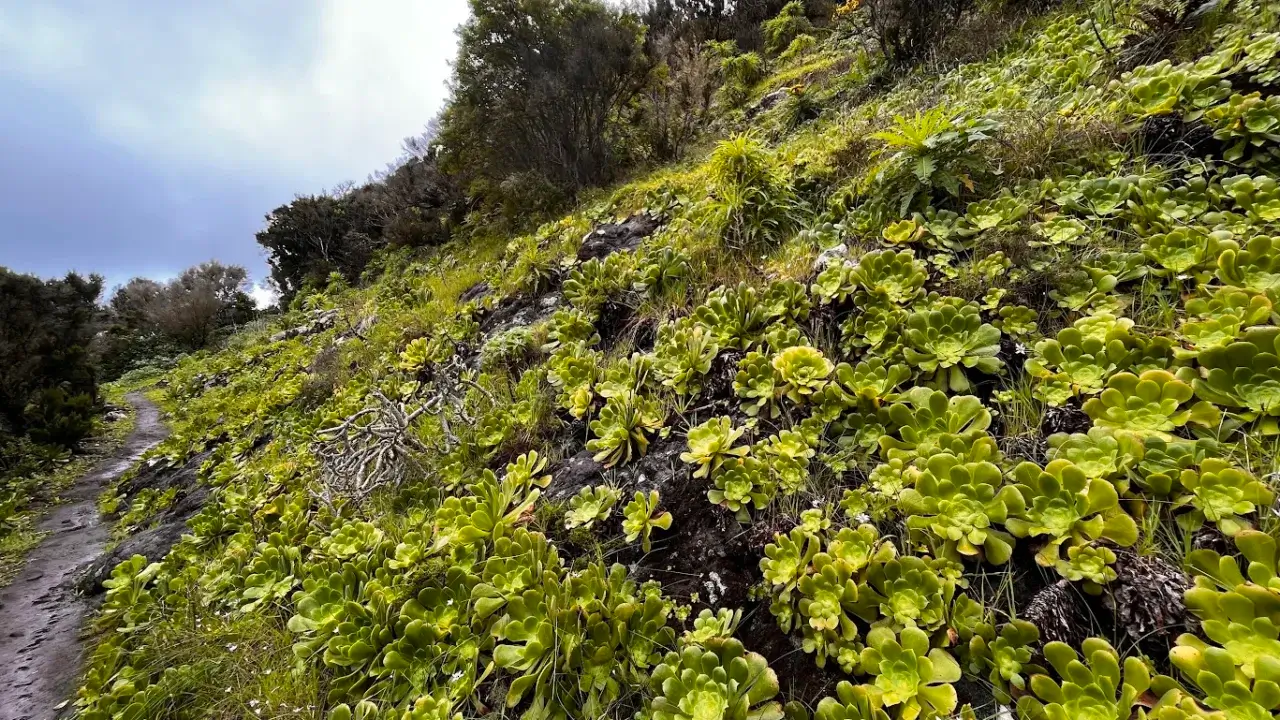
This is the trail at around the first mile / 1.5 kilometers as it winds up a mountain above Chamorga.
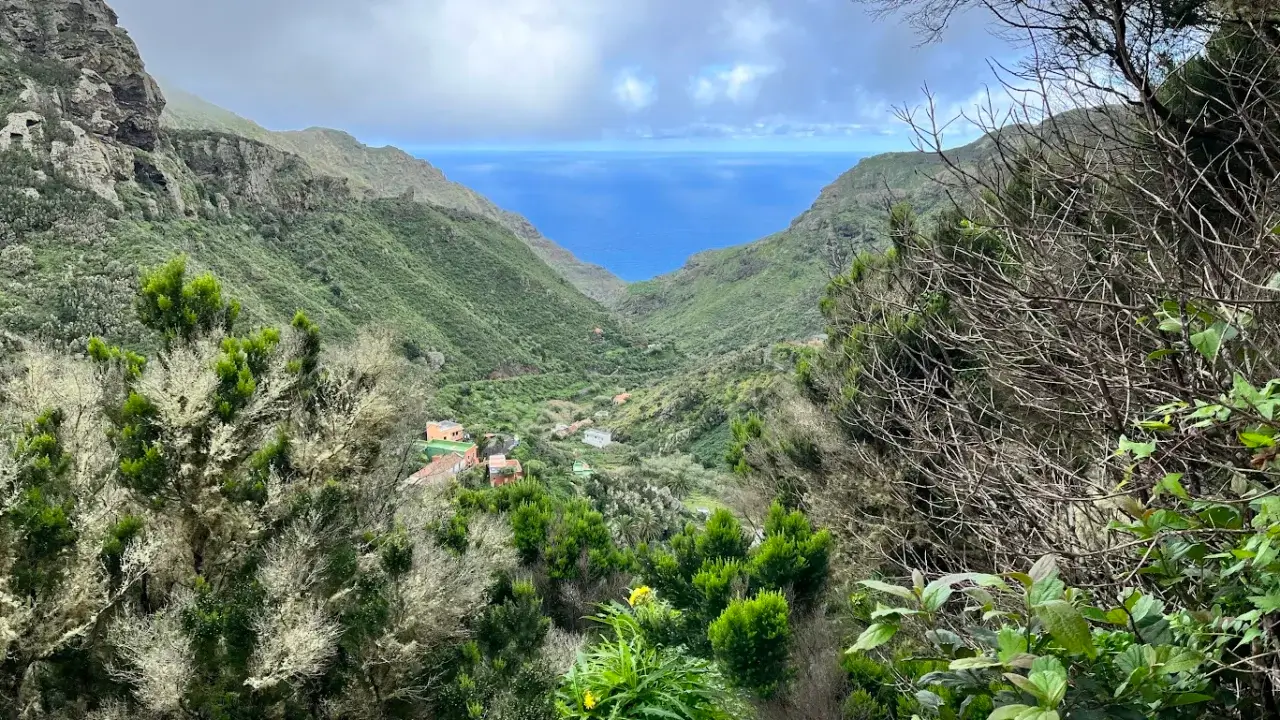
The higher you get, the more impressive the panoramas become. Here you can see the Chamorga village from a vantage point around 600 feet / 200 meters above it. The Atlantic Ocean and Casas Blancas of the TF-6 trail in the distance.
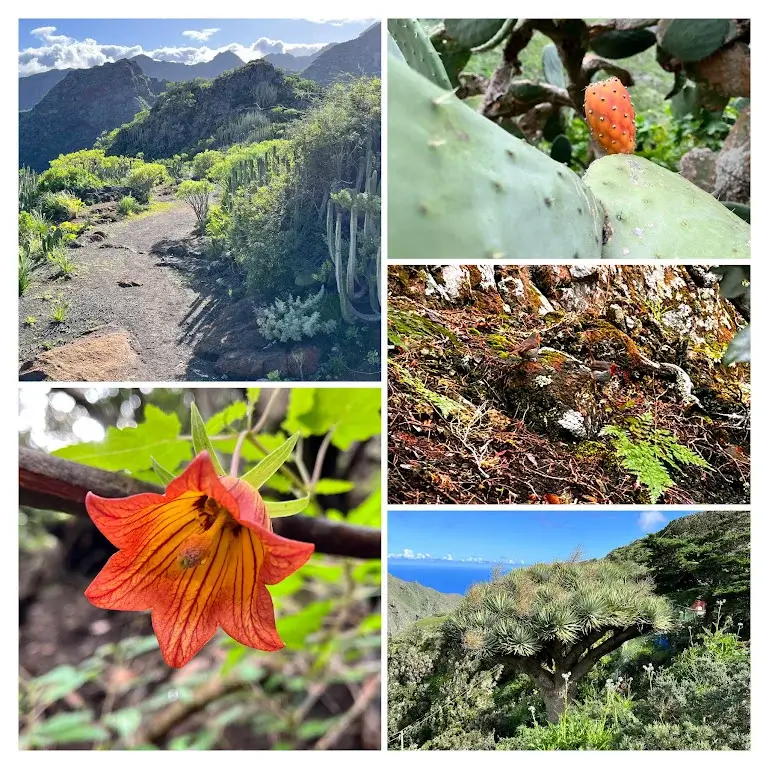
From the start, the trail gives a nice opportunity to observe Anaga’s nature. There plenty of plants and trees, and birds to observe. Of course, there are the omnipresent lizzards, but most often they are too fast to catch, even, with a camera.
La Cumbrilla village
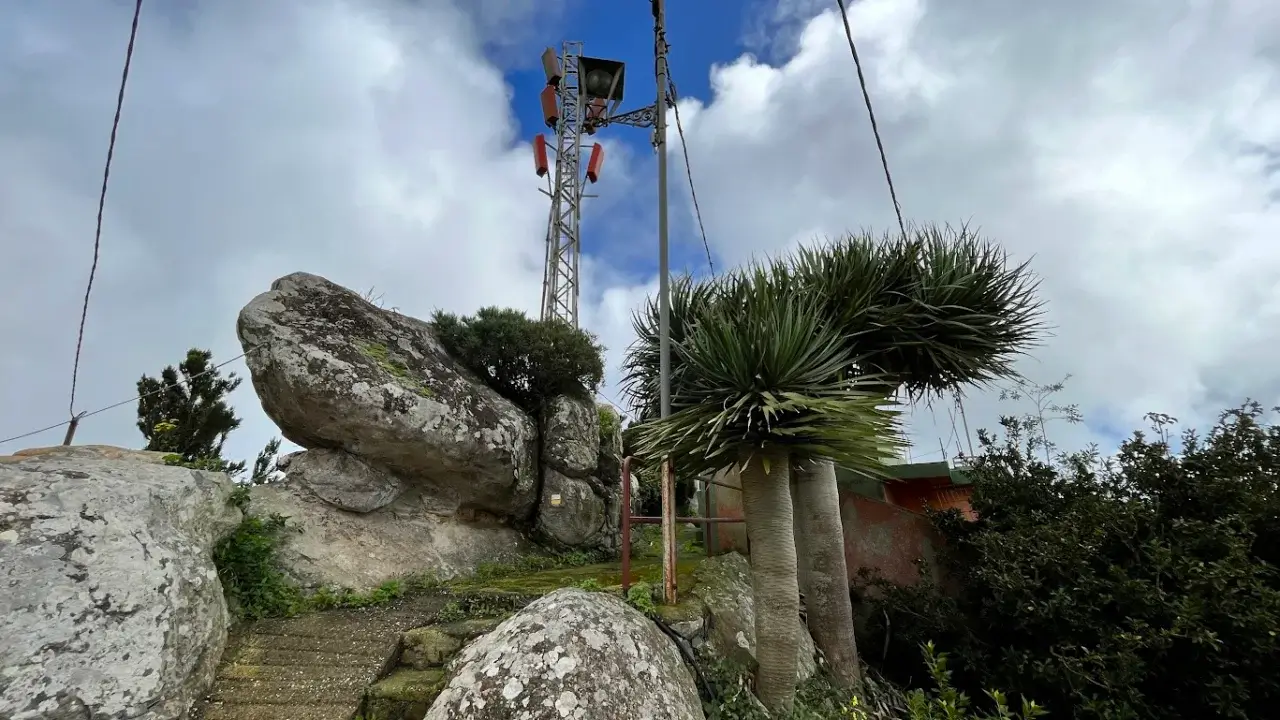
After the first ascent you’ll reach the La Cumbrilla village.
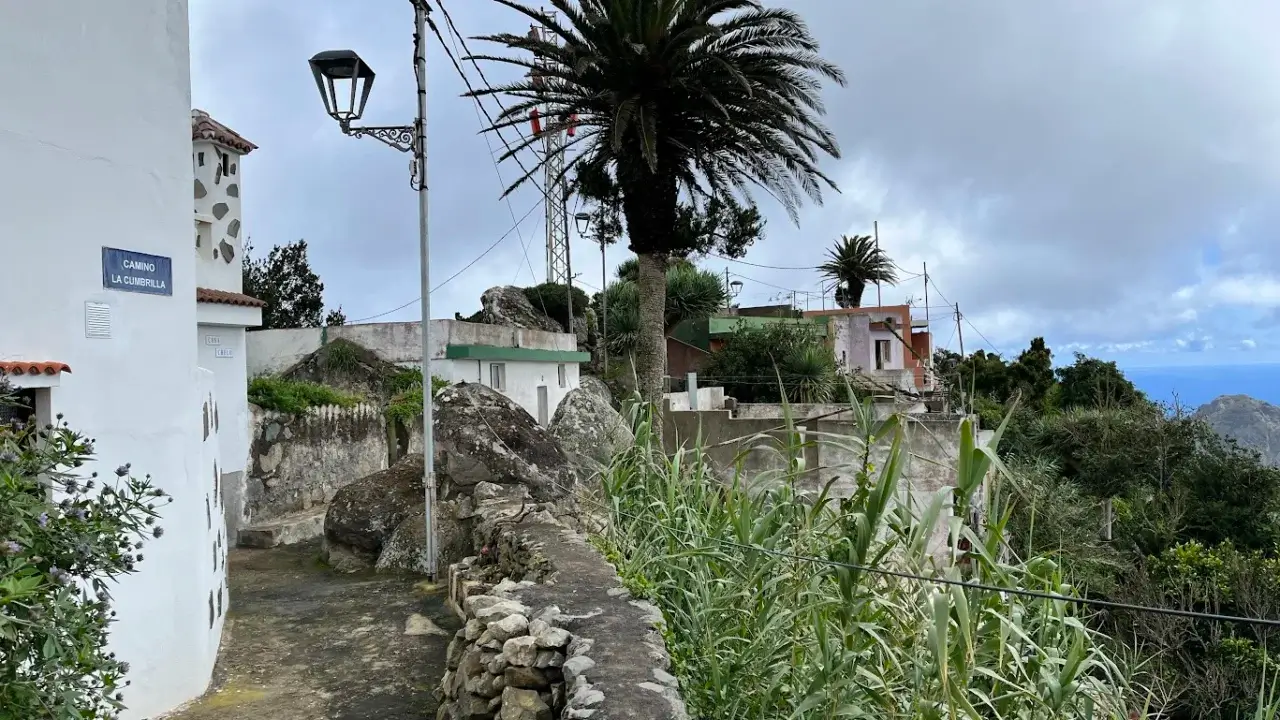
It appearst to not be inhabited, but most houes in the village were in a very good condition, so we assumed the locals are using them as weekend getaways.
Los Laureles
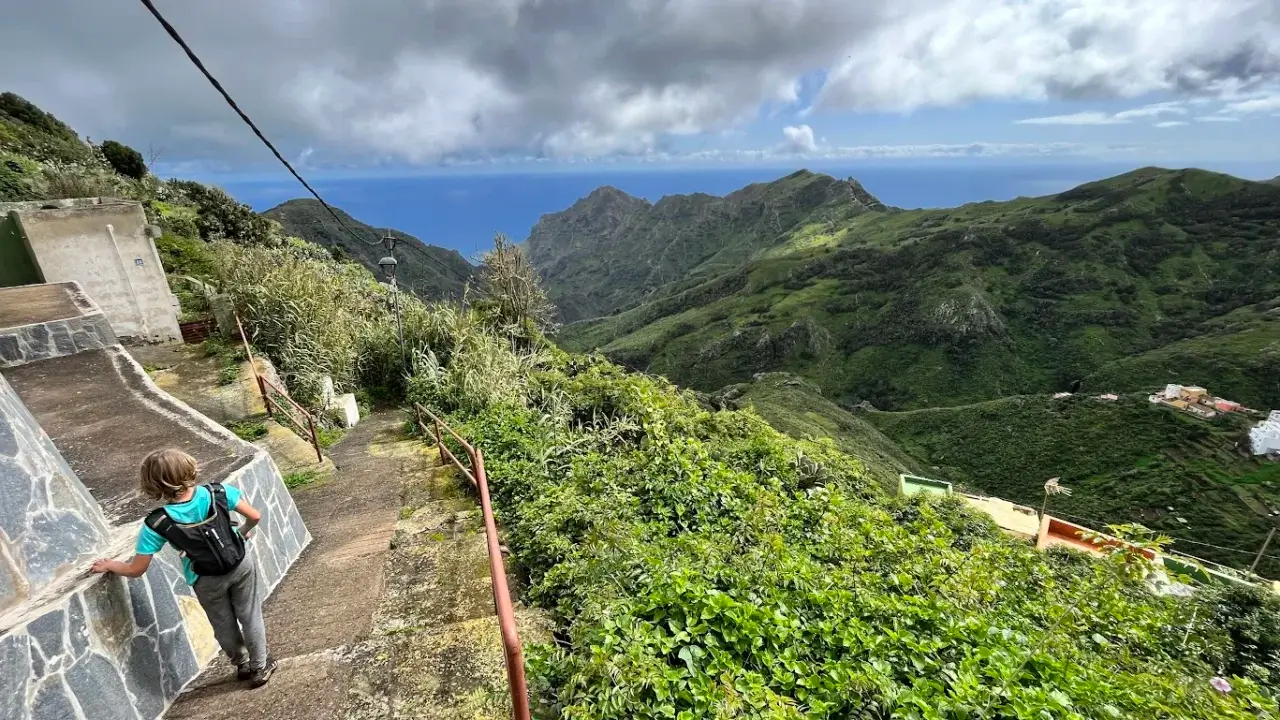
After La Cumbrilla you immediately start your descent down to the Los Laureles village. If you like wild hikes, than the first half of this trail is not for you, as it goes through several villages and the path is mostly a concrete slab.

If you don’t mind the concrete path and some civilization (we didn’t), the nature is as beautiful as it gets in Anaga. Among other things, there is this very large volcanic plug above Los Laureles.
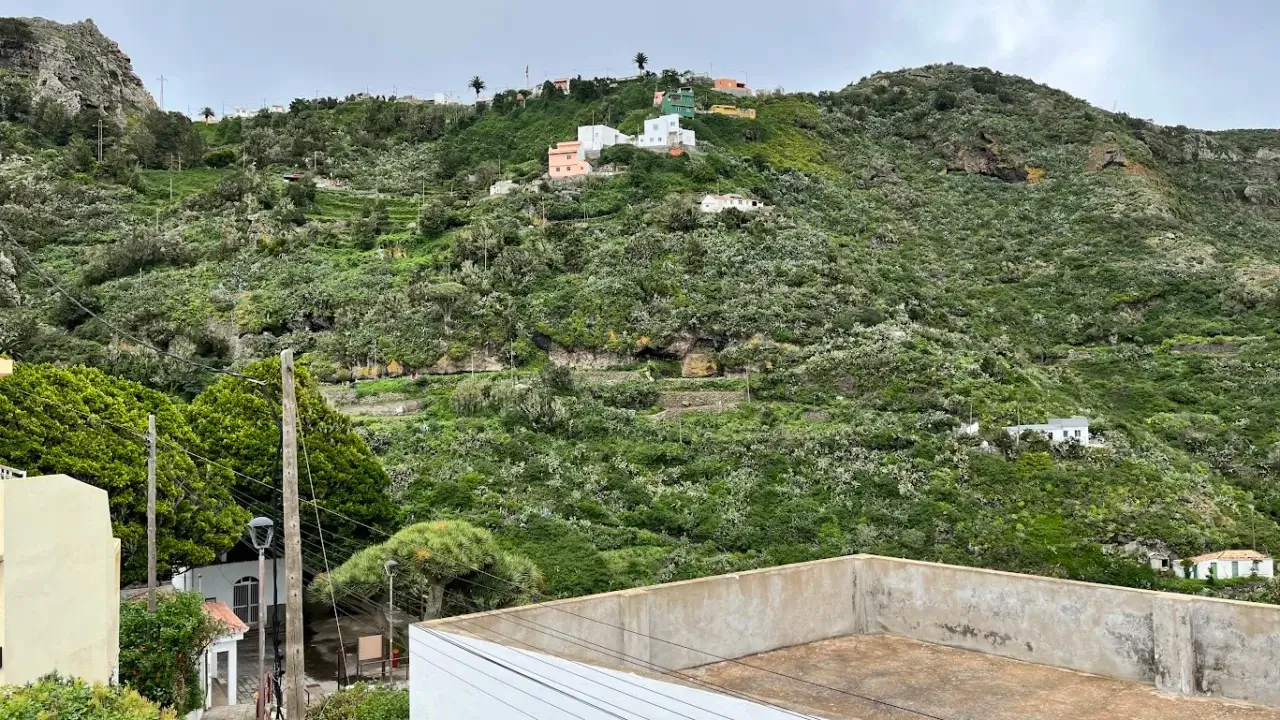
This is a trail where it pays to regularly look back for views equally as good as the ones before you. In this picture – view of the La Cumbrilla village on the ridge, as seen from the Los Laureles village centre.
Lomo de las Bodegas village
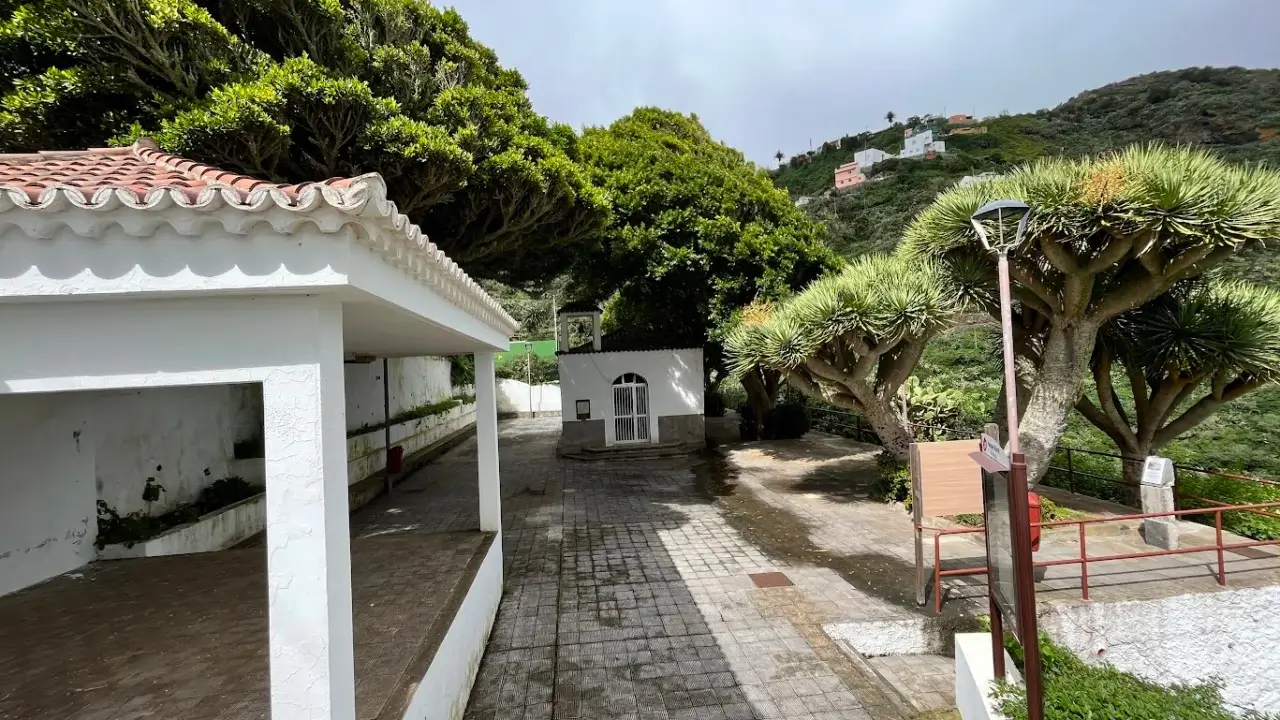
The Lomo de las Bodegas village follows in quick succession after the Los Laureles village. It has the quite nice Ermita de Santiago Apostol church in it, but not much else.
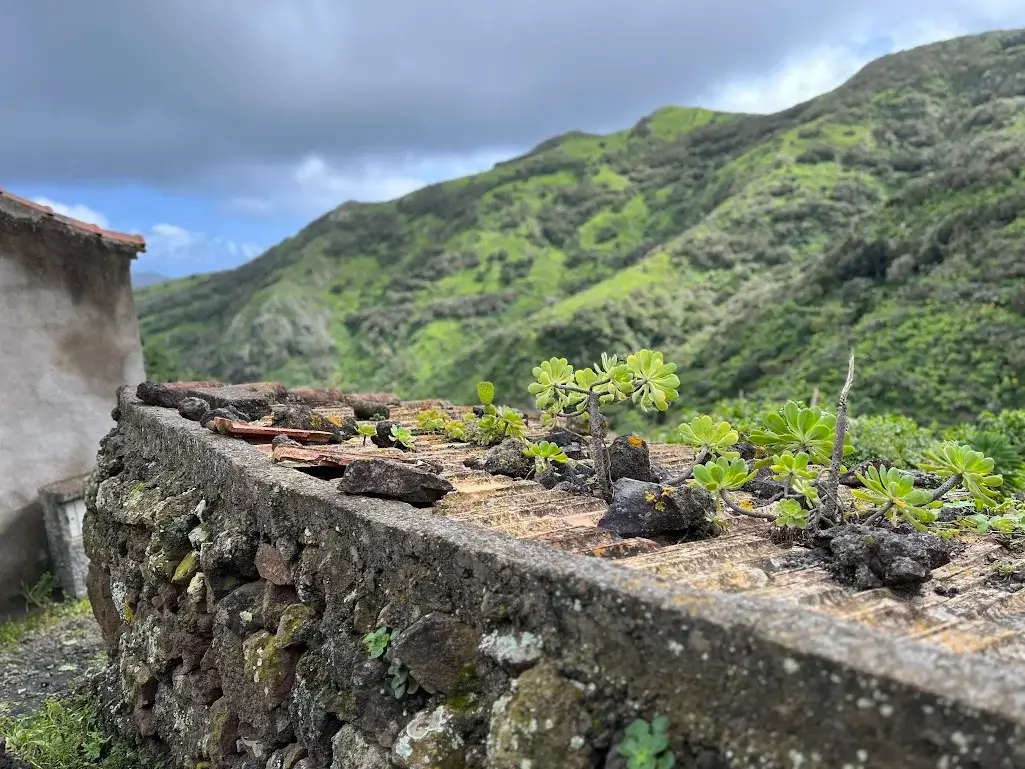
While walking through this village, we thoroughly enjoyed the roofs covered in “Bejeque” as the plant is known locally. The aeonium urbicum has over 30 varieties in the Canary Islands and is considered a good omen by the locals. Hence, they mostly do not remove these plants from their clay shingle roofs.
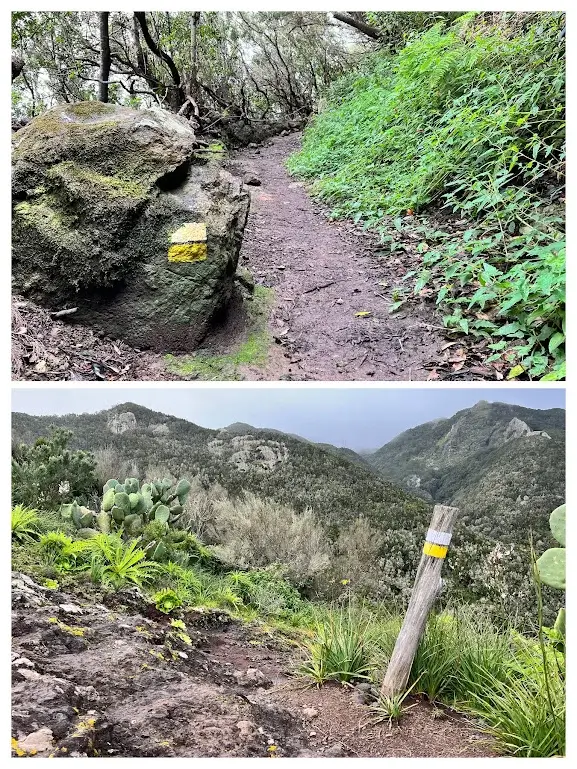
Navigation was not a problem on this trail. While we usually recommend to use a GPS app while hiking on the island to avoid going the wrong way, on the TF-5 you can just hike by following the stones and poles marked in white and yellow. There really were not tricky bits.

If you are hiking this trail with kids, they should enjoy the diversity of plants on the trail and different types of soils. We hiked after a few days of rain, so some light puddles added to the fun.
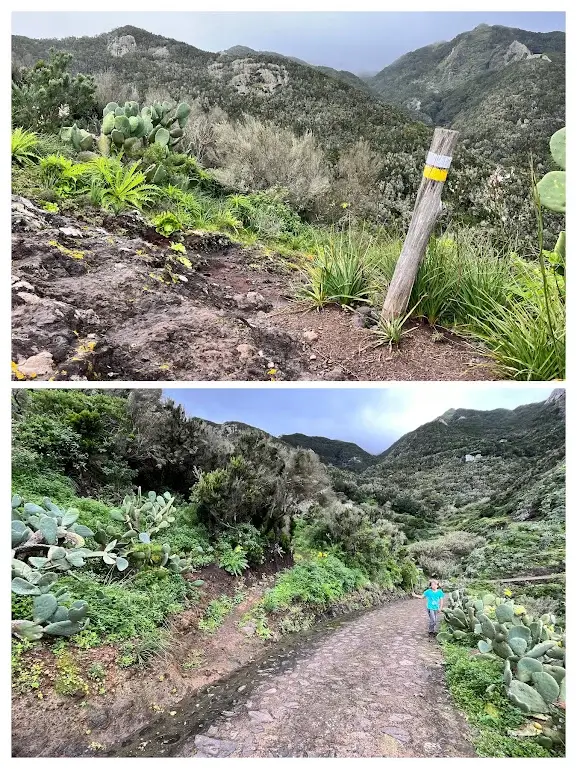
After the Lomo de las Bodegas village there is quite a steep climb. You can choose to either do it on a paved road or a forest path. In the picture above, you can see the trail split. We’d recommend the forest path, but both will lead you to the next stop of the trail.
Cementerio de Santa Modesta
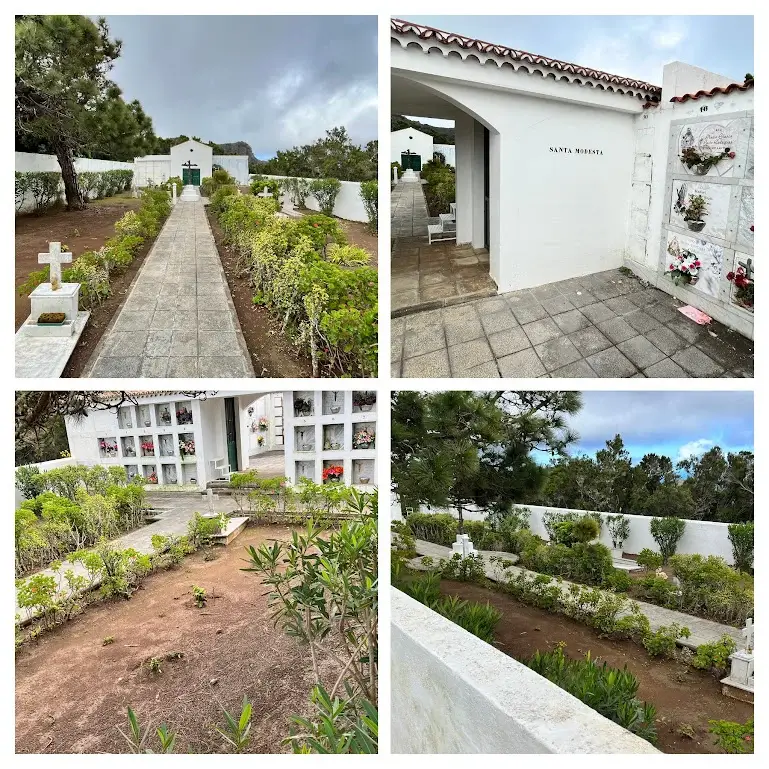
After the ascent from the Lomo de las Bodegas village at around the 2.2 mile / 3.5 km mark you’ll reach the Santa Modesta cemetery. We enjoyed it a lot as a landmark and an introduction to local customs. If you are hiking with a dog, the cemetery has a water faucet from which your pet can drink. It’s probably safe for human consumption as well, but were not sure so didn’t top up our water bottles there. Following the cemetery, finally the wilder section of the trail begins.
TF-5 Trail intersection with the Carretera de la Cumbre / TF-123 road

While the wilder section starts where the trail briefly intersects with the TF-123 road section marked as Carretera de la Cumbre in some maps / GPS apps, the path is in quite good quality. Good maintenance of trails is in general a mark of the Anaga Rural Park and the TF-5 trail is no exception. You are rewarded with a descent here and, except a few sort instances, the trail goes mostly downhill from here.
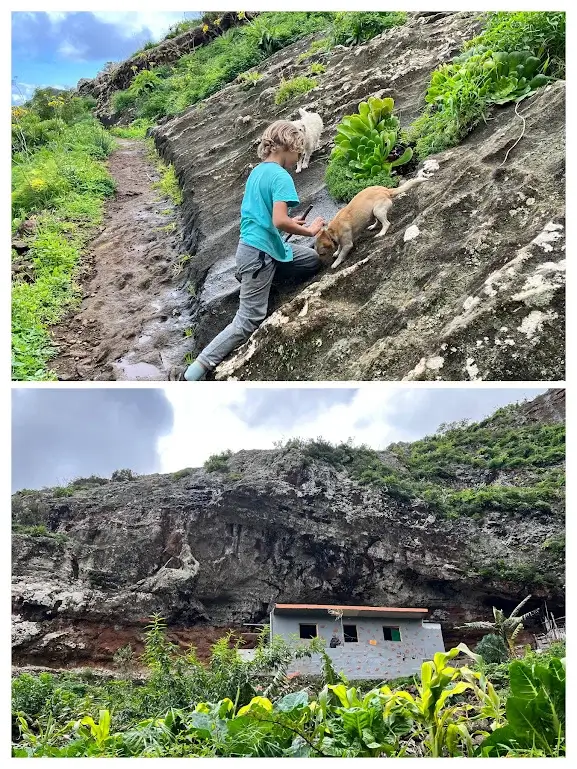
As you descent the trail, you’ll pass a finca that’s miles from the nearest village or other inhabited house. It appeared that this property was inhabited by a single man with quite a lot of dogs. These dogs greeted us already at the TF-123 road intersection and almost “led” to the house. It must be their “shtick” – we assume quite many tourists do reward them with scraps of food. They got plenty of pets from my son.
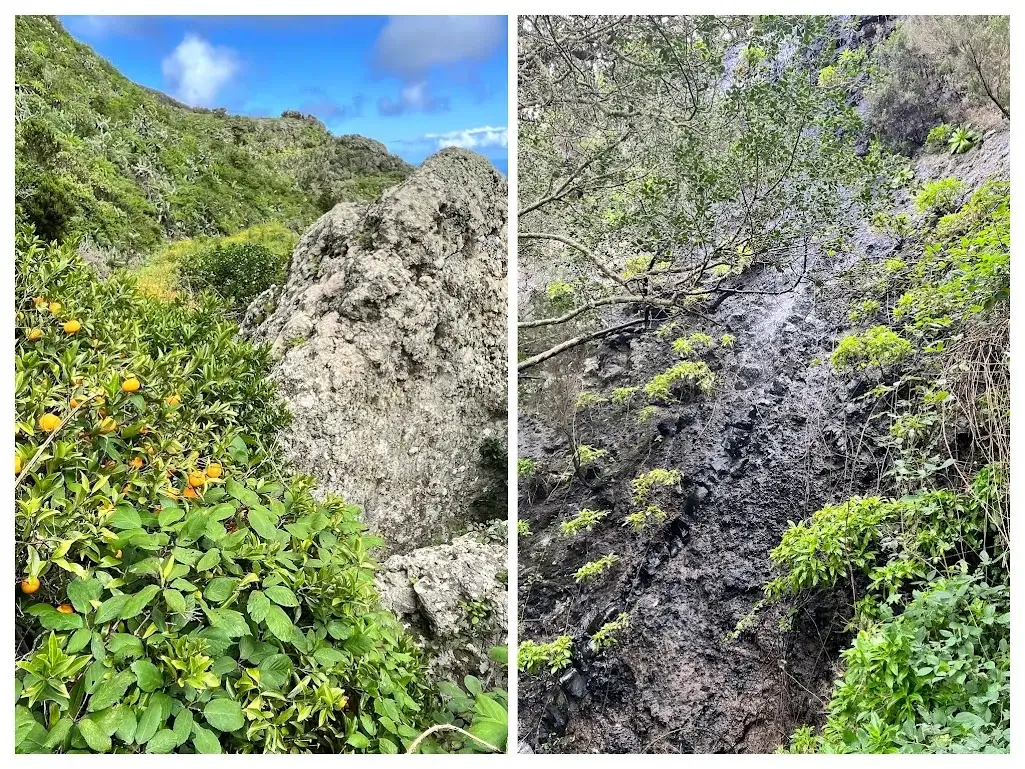
A 10 minute walk from the inhabited house there is another property that seemed abandoned, but had a fence around it. If you have sufficiently long hands and the fruit are in season, you might help yourself to some oranges.
At around 3.4 mile / 5.5 kilometer mark it’s finally the ridge walk and the highlight of the TF-5 trail. Occasionally the view is blocked by vegetation on one or both sides, but in these instances take a few steps to either side and you’ll get views like in the video above. If you walk a bit further on the ridge, the trail goes over some rocks and you get a proper unobstructed 360 degree view of Anaga mountains.
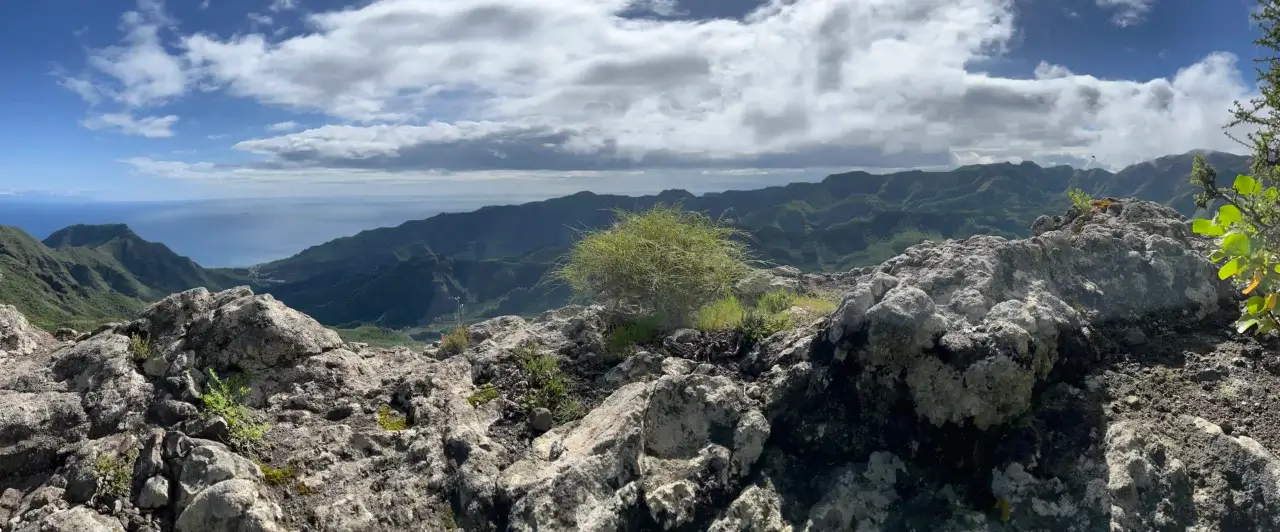
The scenery on the ridge walk is absolutely stunning. Usually a lookout (“mirador” in Spanish) is created in such locations. However, on the TF-5 trail the whole ridge walk is one great lookout.
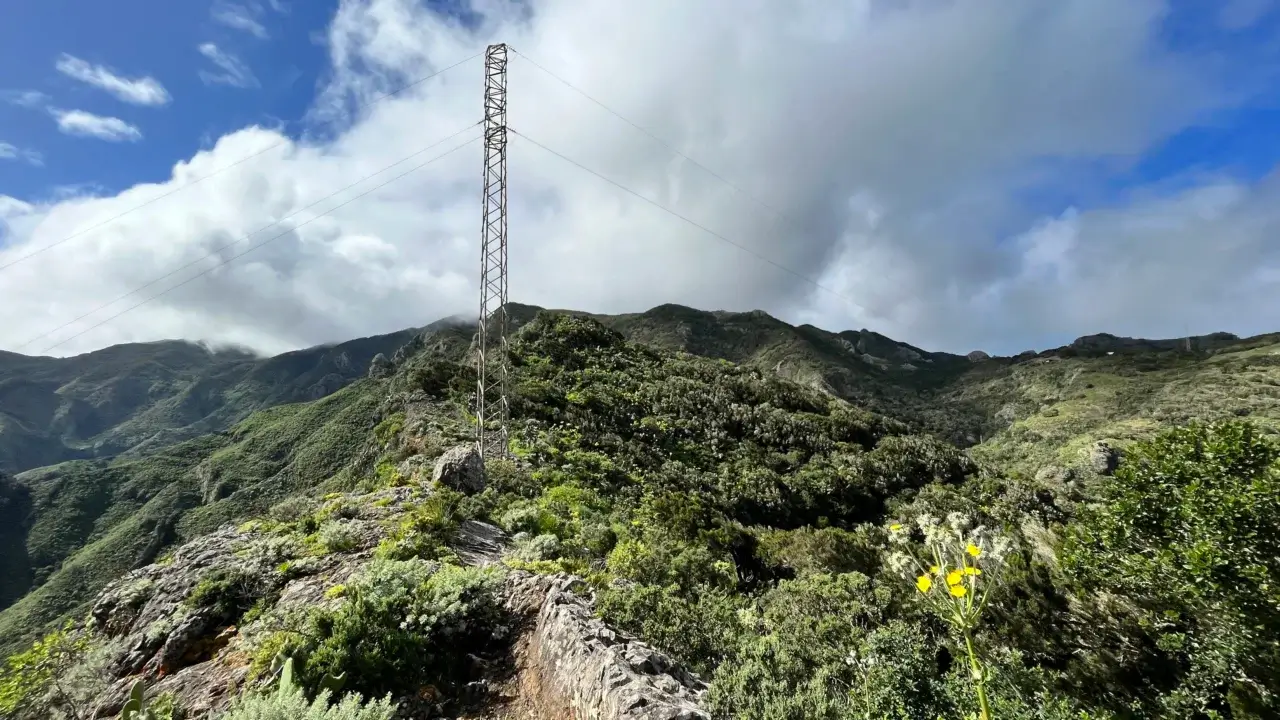
This is what the ridge walk looks like third-of-a-way when you look back towards Chamorga. Unfortunatelly, there’s the electricity line pilon, but even with it in th e picture the view is very nice. Of course, it’s three times better in real life. You just can’t fit not only the view, but but the ambience, the sounds, the smells in a blog picture nor a YouTube video.
Here’s a short video of the panorama when you reach the Las Casillas settlement with a few houses in use.
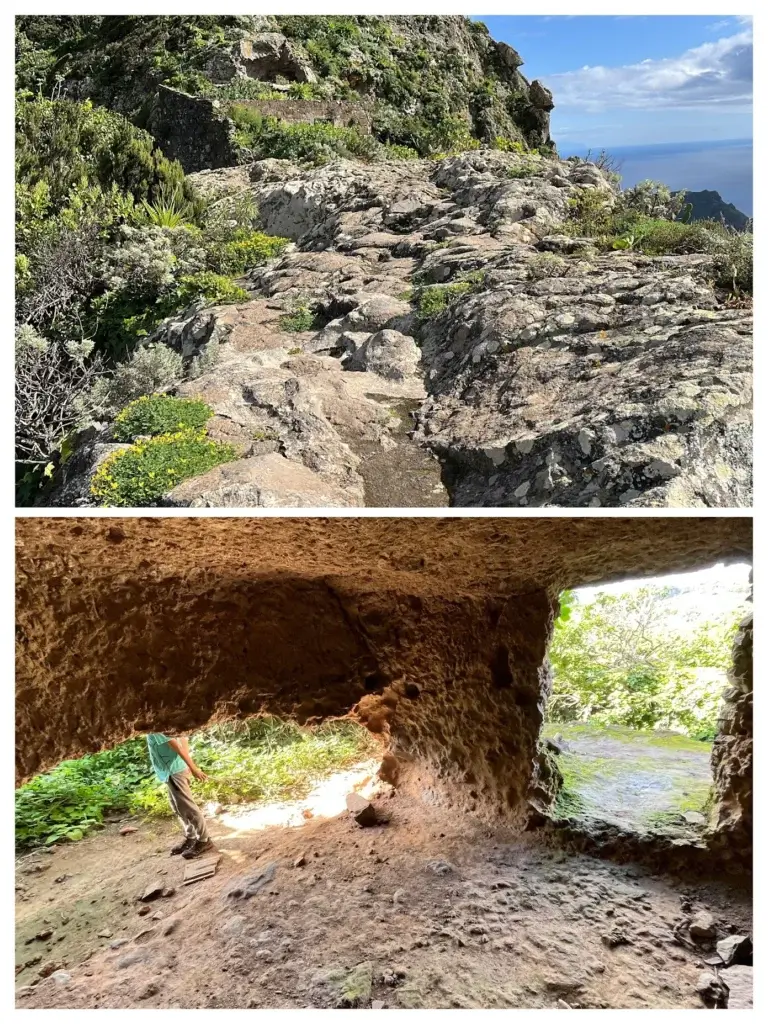
There is also an abandoned house which you can explore. There’s more of it in the longer trail video.

After around 1100 yards / 1 kilometer the ridge walk ends and you turn to the left and start the gradual descent towards igueste. You’ll notice this serpent like geological formation in the centre of the image. It’s one of the mosti visible lava dikes that we’ve seen in the Anaga mountains.
In case you’re wondering, lava dikes are formed when magma presses through a fracture in another rock and then solidifies as a ‘sheet intrusion’ forming these interesting stone walls. And, yes, we had to look up what a dike is on Wikipedia after hearing the word from a local hiking guide. There’s another great lava dike on the TF-8 trail (link to a picture) between the Afur village and Playa.
By the way, this picture also shows you most of the ridge walk in the upper right corner.

This is also the moment when you’ll notice Igueste in the distance and the trail’s end will approach.
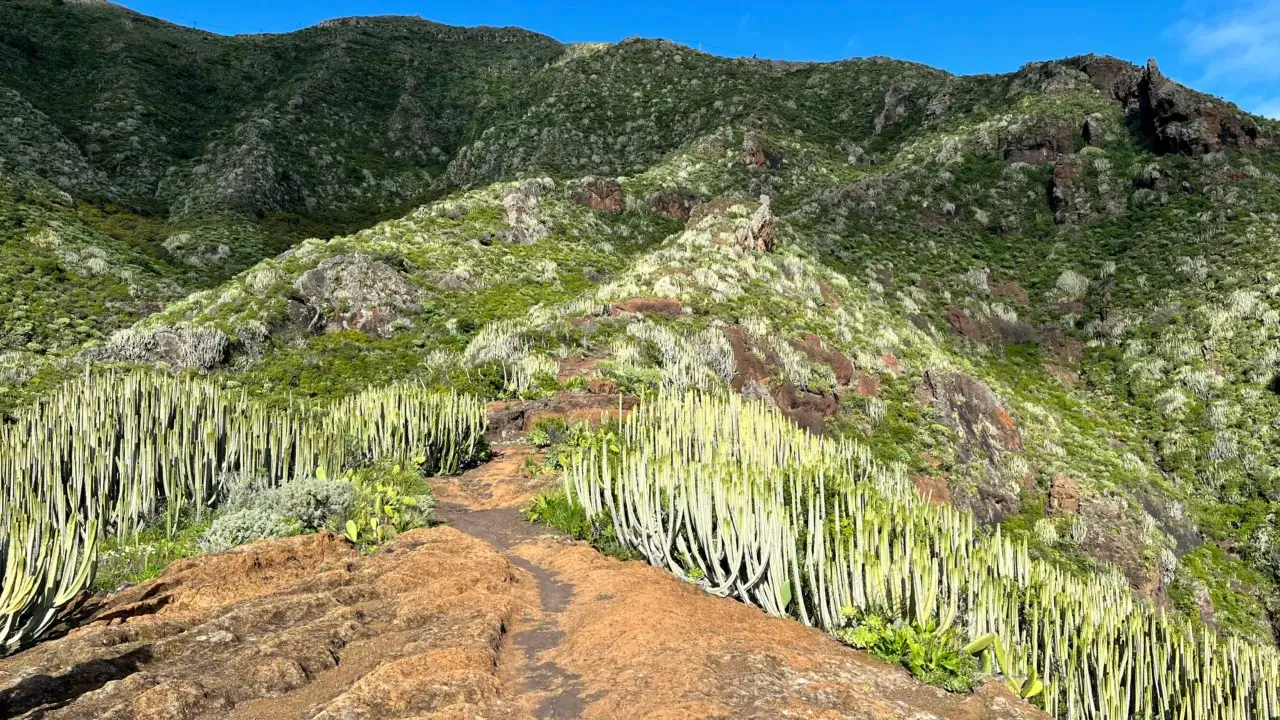
Backwards look at the descent from the ridge walk. The trail is very pleasant here, formed by a tough rock interspersed with gravel.
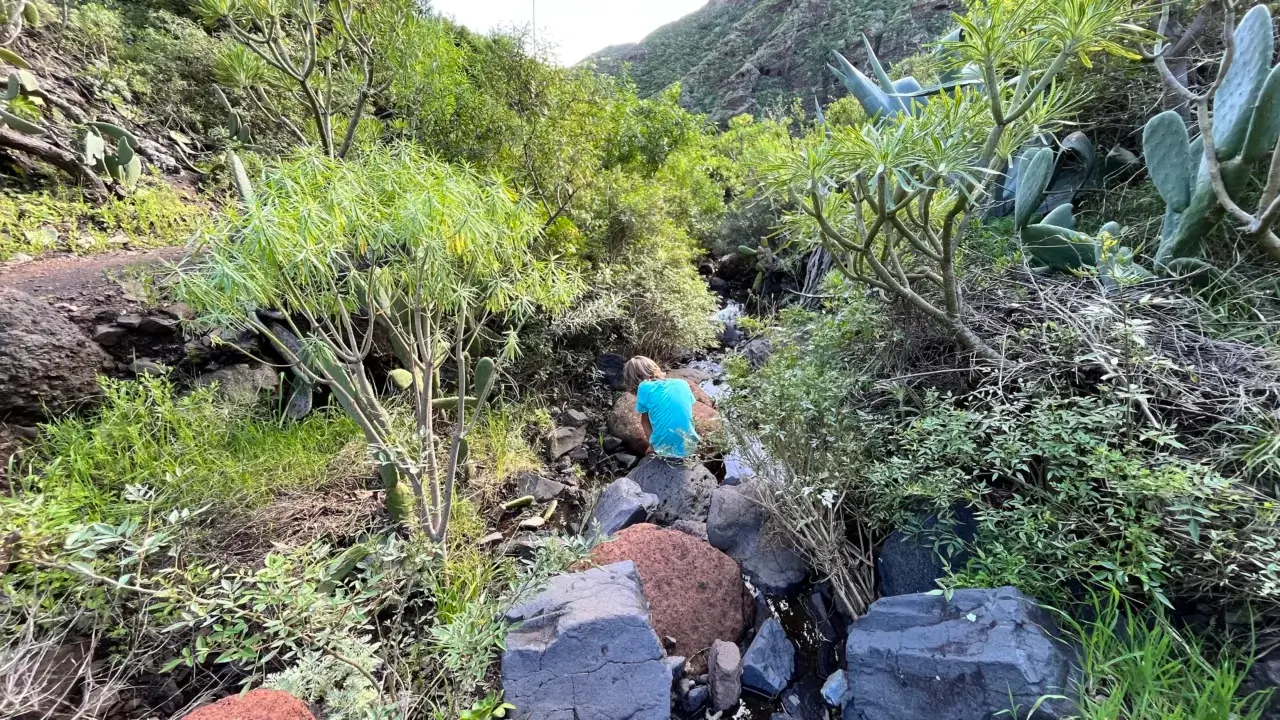
If you are hiking with kids, they will most likely enjoy this trail as it’s not hard in the ocean direction, there’s lots to look at, including a small stream and plenty of rocks to climb on.
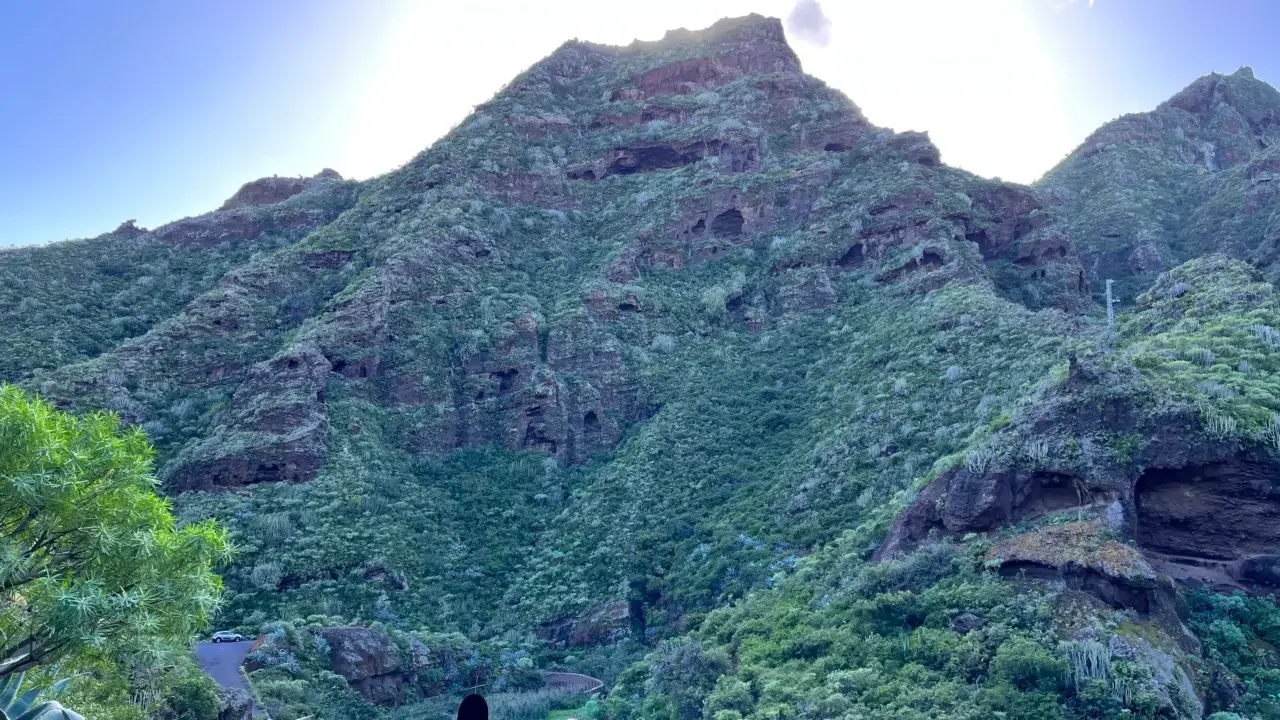
As you descent almost to Iegueste where an area of fincas starts, there is one last surprise of the trail – a mountain with caves in it that is very similar to the Chinamada caves which you get to see from the TF-10 and TF-11 trails.
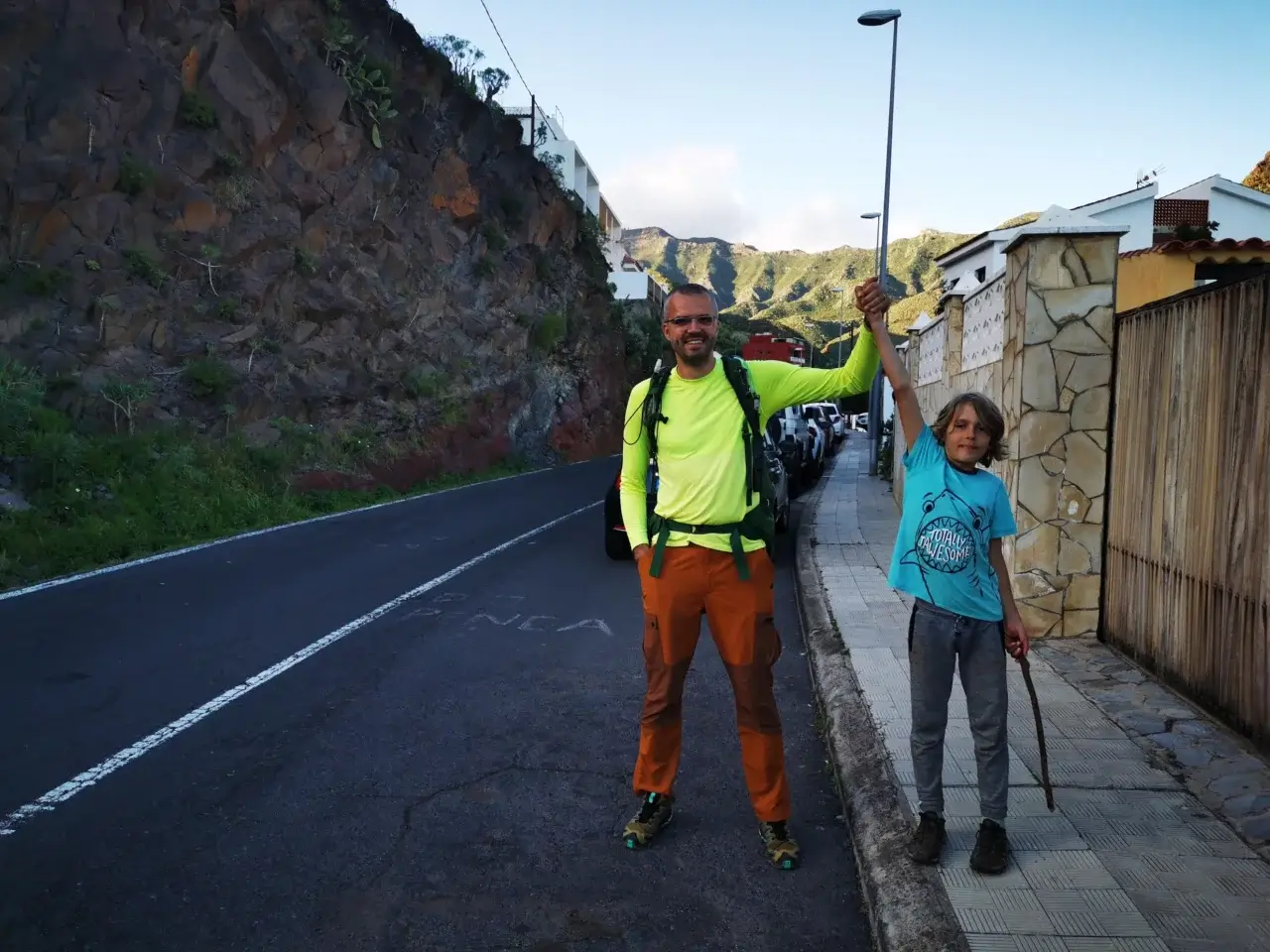
This is me and my son in Igueste San Andres, where we were picked up by our family. The TF-5 ridge walk, again, in the distance above us.

One last tip how to properly end the hike. If you are picked up with a car, we absolutely recommend to stop by at the Bambola ice creme and gofres cafeteria in San Andres (Google Maps link). This will be a well deserved treat after this scenic hike!
How to Get to the Trail Head in Chamorga
By Car
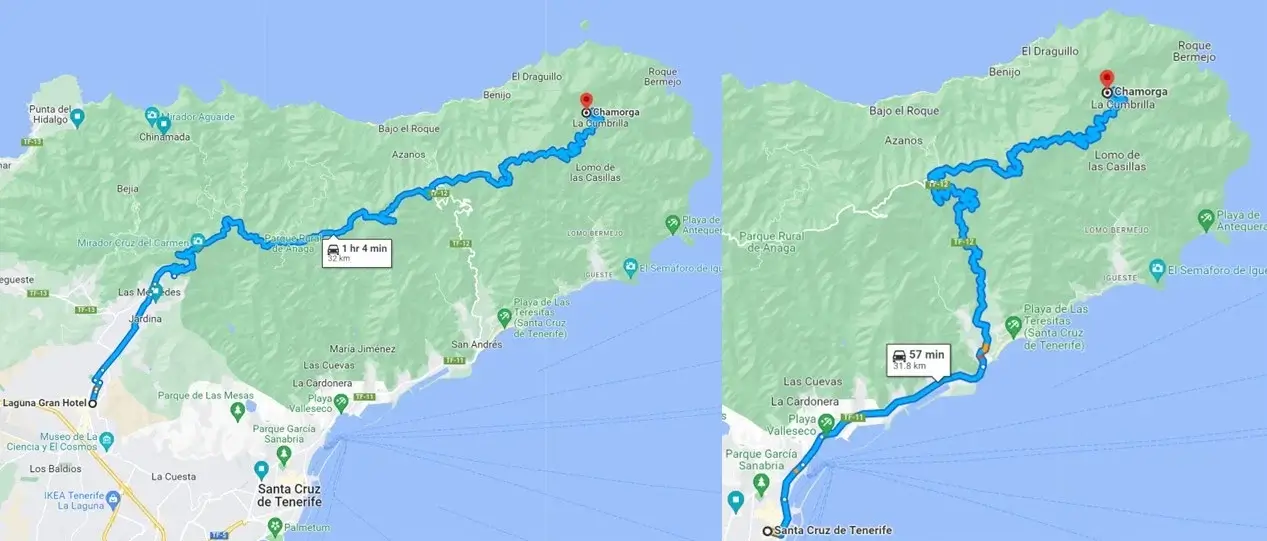
To get to the trail head in Chamorga by car, you’ll need to drive from the capital Santa Cruz de Tenerife on the TF-11 road or the historical town of La Laguna on the TF-12 road (whichever road is closer to your departure location).
The road between La Laguna is much more scenic, as more of it goes through the Anaga Rural Park. However, this is not for the novice driver, nor anyone who easily gets car sick. The road from Santa Cruz, past the Las Teresitas Beach is relatively calmer and less winding (but not too much).
While both routes are only 20-25 miles / 32-35 kilometers long, they really do require at least 1 hour for an experienced driver. If it’s your first time driving on mountain roads, easily plan 1,5 hours to get to Chamorga or Benijo villages.
All major car navigation apps – Google Maps, Apple Maps, and Waze – work well in Anaga, but always exercise caution, especially, if you go off paved roads.
We liked to use navigation apps when driving in Anaga, as they allowed to prepare for particularly sharp turns.
Also watch out for the usual “road idiots”. While locals are extremely polite and will wait for a safe stretch of road to overtake you, the same cannot be said about tourists. This particularly applies to motorcyclists who’ve rented powerful bikes and often use Anaga roads as a racetrack of sorts without regard for their own safety or that of others, as you can see in the video above.
By Bus
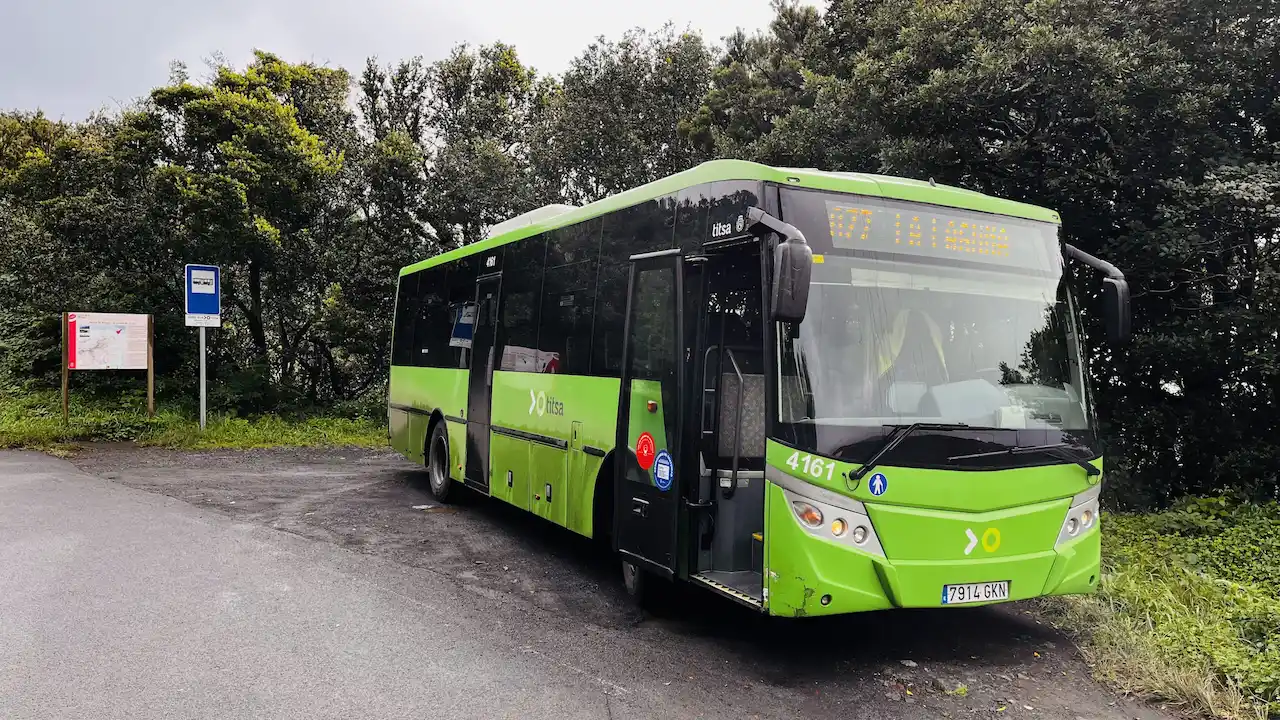
Public transportation by bus (called “guagua” on the island) is an option to get to and from Chamorga. While using a bus to get to the trailhead of the TF-5is the more sustainable option, it does require some flexibility and planning, as the schedules are often limited to remote locations, particularly, in Anaga.
You will take bus 947 from the Santa Cruz Intercambiador or bus terminal.
The ride will take approximatelly 1 hour and 30 minutes. I must warn those who easily get car sick – don’t take this bus. My son and I never get car sick, but the last 10 minutes of our bus ride really put us on the verge of almost having to ask the driver to exit and walk the last stretch of road by foot.
There are only 3 buses per day on working days, and 4 during weekends and festive days.
WORKING DAYS
| FROM SANTA CRUZ | FROM CHAMORGA* |
| 05:10 | 06:20 |
| 15:00 | 16:30 |
| 18:00 | 19:25 |
WEEKENDS AND FESTIVE DAYS
| SANTA CRUZ | CHAMORGA |
| 07:00 | 08:20 |
| 10:15 | 11:45 |
| 15:00 | 16:30 |
| 18:25 | 19:55 |
Check the Titsa website for the current bus 947 running schedules between Santa Cruz and Chamorga.
The ticket price was around 2 euros.
From our experience, you can trust public transport connections and schedules on Google Maps. If a bust does not arrive on time, it is most often just delayed.
Hiking with a Guide
For those who prefer a guided excursion, there are local companies offering guided hikes on the TF-5 trail and other trails in Anaga.
— AD —
— END OF AD —
These organized tours provide certified and knowledgeable guides who can share the area’s history, flora, and fauna while ensuring the group stays on the right path. Additionally, they often offer transportation directly from Santa Cruz de Tenerife or La Laguna. This eliminates the need to drive on the narrow roads yourself.
Guides can also be found through the Tenerife Hiking Community Facebook group. Hiking with a guide can be a great option for those looking for a more structured and informative experience on the trail. All guides through Get Your Guide and most certified guides found through other channels will provide insurance for participants during the hike.
Packing List for Hiking in Anaga
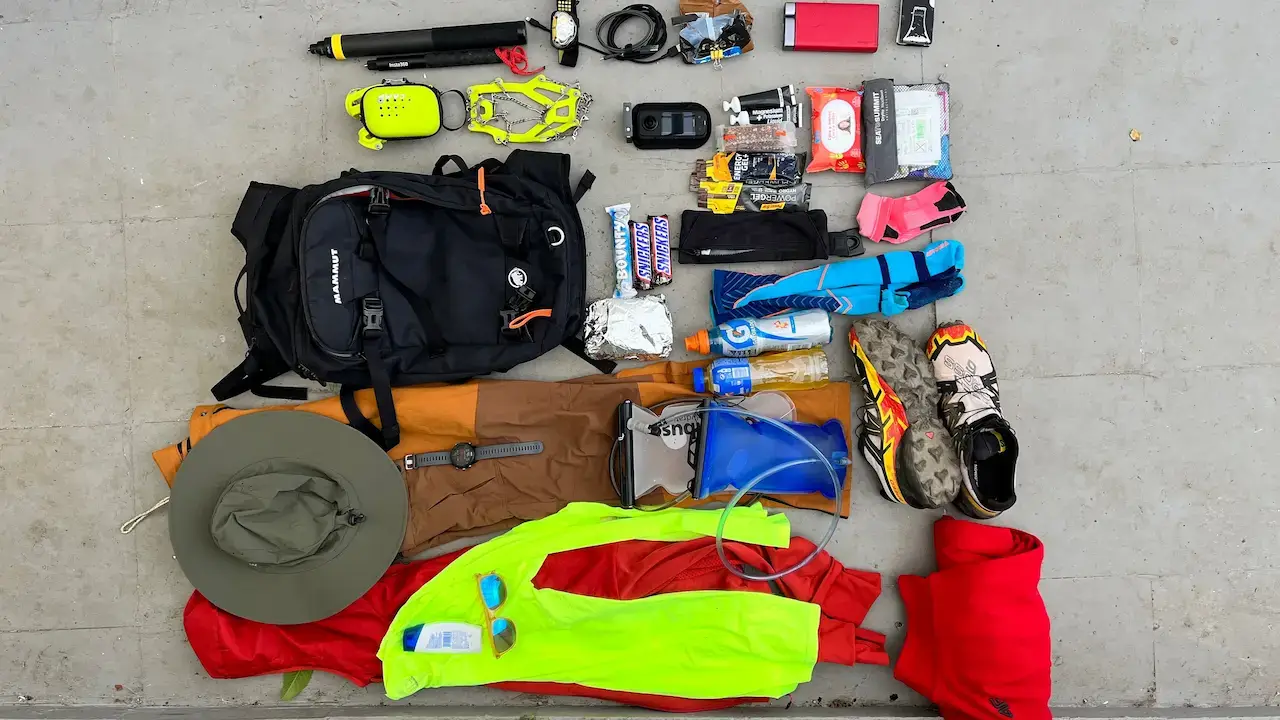
Food and Hydration
When preparing for a hike in the Anaga Rural Park, it is important to ensure you have enough water and food (in that order). Sufficient amount of water is particularly important during the hot season month of May-September as many of the best Anaga trails have large sections in open terrain without tree coverage.
Our suggestions for food items to bring along include:
- Sandwiches. Some towns and villages have restaurants and small cafes. However, there are trails that are less well served. Better to come prepared.
- Trail mix of nuts, dried fruits, and seeds to provide a quick energy boost.
- Bananas and other fresh fruits. Apples and oranges are also good choices as they stand up to heat and don’t get easily bruised.
- Energy bars and energy gels with sodium. Need for these will depend on your physiology and length of the hike, however, I would suggest to take along at least a few energy bars or sodium (and caffeine) gels in this trail to compensate sweat loss, avoid leg cramps and give an extra energy boost. If you haven’t hiked steeper hills in very hot climate before, be ready for significantly higher energy and fluid loss. You can stock up on these in the La Laguna Decathlon.
For hydration, it is vital to carry enough water or other liquids to last the duration of the hike. It is best to assume that there are no water sources en route (very few trails have a cafe on them, and even fewer have a pottable water fountain). A general guideline is to bring 0.5 to 1 liter of water per hour of hiking, depending on personal needs. I personally took 2-3 liters per hike and generally consumed it all by the end of a trail. It might be more during summer months, and less if you’ll hike in the November-March period or are a smaller person.
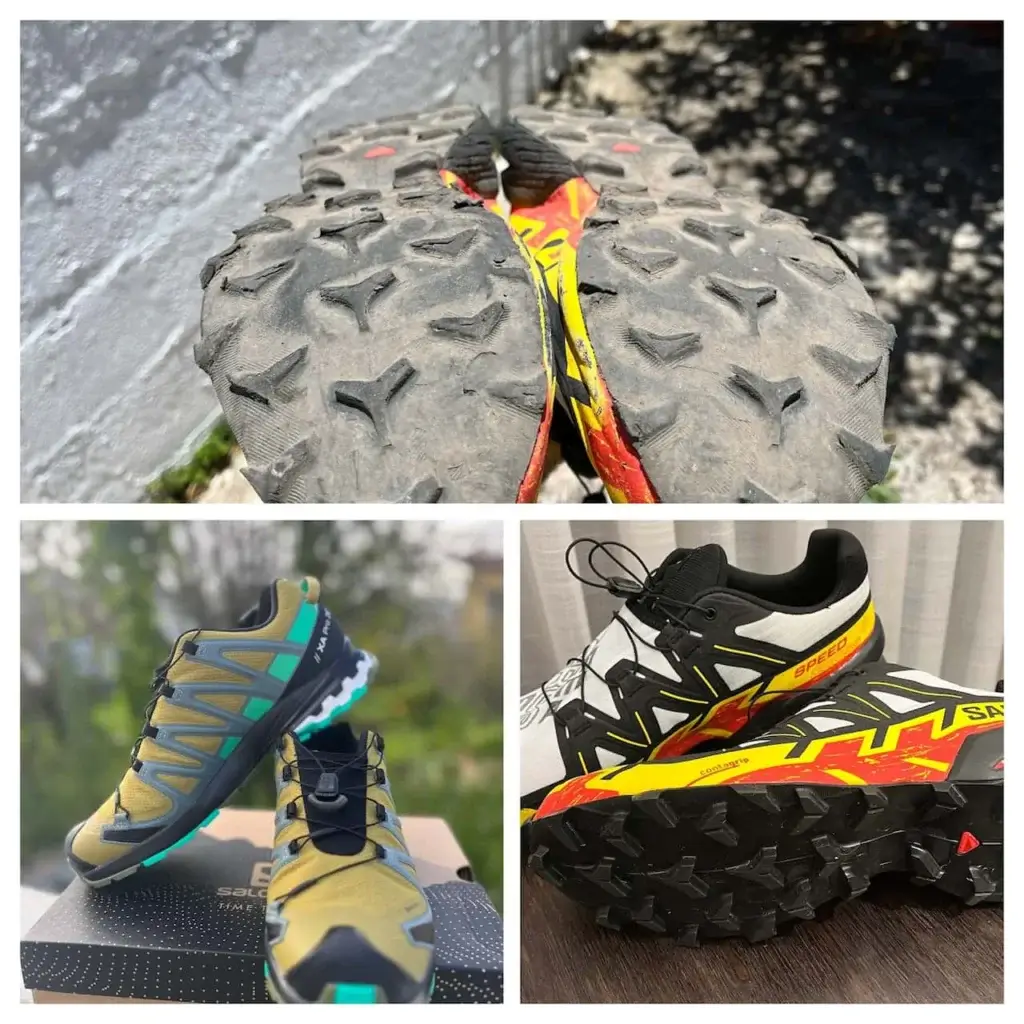
Equipment
While the necessary gear for hiking largely depends on individual preferences, we’d classify the following as necessary items on hikes in the Anaga Rural Park (in priority order):
- Comfortable hiking shoes and hiking socks. Hiking boots are not necessary, but definitely get hiking shoes with a good protector and toe protection. Hiking boots might be particularly uncomfortable during the hot season from May to September. We’re quite fond of the Salomon, Merrel, and Hoka trail shoes.
- Water flask or “camelback”. If you use a water flask, carry with you a sufficient amount of water for refills.
- Hiking backpack. A lightweight one-day backpack with comfortable straps will allow you to carry all necessary items during the hike.
- Sun protection. Bring sunscreen, sunglasses, and a hat to shield you from the sun during the hike.
- Power bank to charge your phone, as most people take a lot of pictures and videos when hiking in Anaga. You also should have your phone charged in case you need to call for help, although phone coverage can be spotty on this trail.
- First aid kit. A basic kit with band-aids, pain relievers, and any necessary personal medications can help with minor injuries or illnesses.
- Rain gear (necessary only in the December-February period).
Optional gear:
- GPS watch or a GPS device. This will save your phone battery even if you’re not a ‘quantified self’ zealot.
- Walking sticks, if you are used to them or your sense of balance is not that good.
Markings
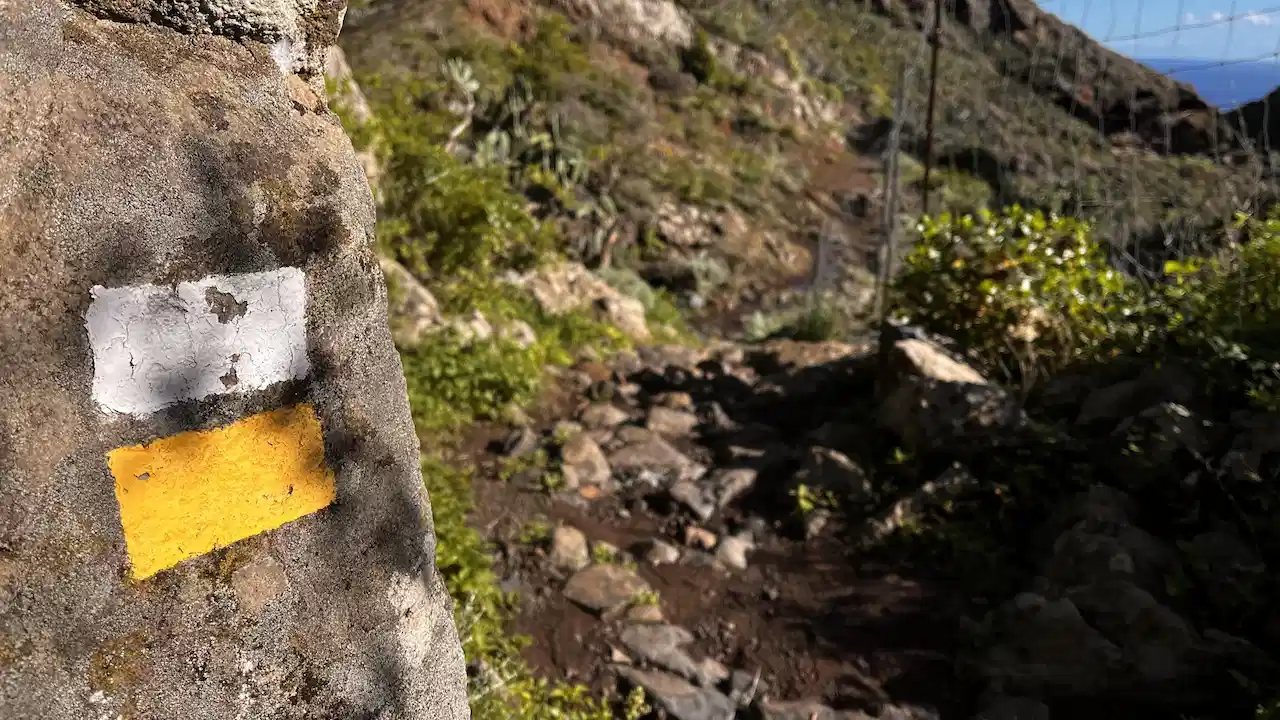
All Anaga trails are well-marked with the typical white-and-yellow flag signs painted on rocks and other objects in places where there’s a chance you might choose the wrong direction. While most Anaga trails are easily navigated even without a map or a GPS device, we recommend to have a trail map on your phone and periodically check if you’re on the right path.
Some trails like TF-11, TF-8, TF-2 and TF-4 have spots where the navigation flags are not easily visible and you can take a wrong turn relatively easily. Our favorite GPS apps were Maps.me and Wikiloc, but others like AllTrails and Komoot are also widely used.
Be sure to download the necessary maps and routes before starting your hike. While there is phone reception on most routes, data connection is frequently a problem.
Facilities on the Trail (Cafes, WCs)
- Casa Alvares cafe in Chamorga. The cafe has a WC.
There are no cafes on the trail. You’ll be able to buy something once you reach Igueste, so come prepared.
Safety
General Tips
Summer: During the summer months, we recommend bringing plenty of water, sunscreen, and wearing appropriate headgear and clothing to protect against the sun. The heat can be very intense, so it’s essential to shield yourself, stay hydrated and take breaks when needed.
Rainy Season: In the rainy season, the trails can become slippery and more prone to landslides. Wear shoes with good traction, bring a rain jacket or a rain poncho, and be prepared for sudden changes in weather conditions. Remember that the temperature on average decreases by 1.8 degrees F / 1 degree C for every 100 vertical yards / vertical meters. If the temperature is still pleasant at ocean level in Santa Cruz, it can be quite cold when arriving in Chamorga and ascending.
Closed Sections of the Trail
The TF-5 has no closed trail sections.
Do You Need a Permit to Hike the TF-5?
No permit is required to hike the TF-5 trail.
Only Sendero el Pijaral (former TF-7 trail) requires a free permit in the Anaga Rural Park.
Do You Need a Guide to Hike the TF-5?
Hiring a guide to hike the TF-5 trail is not required, as the trail is well-marked and easy to follow. However, if you’re unfamiliar with the area or prefer having someone knowledgeable about the terrain and flora/fauna, hiring a guide can be a helpful option.
Dangerous Animals and Plants
Tenerife has no dangerous fauna, and very few somewhat dangerous plants that can cause skin and eye irritation. These are not an issue on the TF-5 trail.
If you hear something rustling in the grass, it’s just a family of lizards, as there are no snakes on the island (thank god!).
Can You Hike the TF-5 with Children?
We would qualify the TF-5 as child friendly if the kids are reasonably fit as there are some longer ascents. I did the trail with my 9yo, but woul say the trail is best for kids 12 and up.
Large parts of the trail are in open terrain, particularly from the ridge walk onwards. Critically evaluate your child’s ability to withstand heat, and bring a hat, sun screen and enough water.
Mouflon Hunting
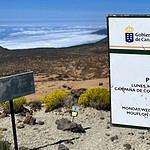
Mouflon hunting may rarely take place in the Anaga Rural Park. If it’s planned or ongoing, there will be signs at the trailhead and at regular intervals. Choose another trail if mouflon hunting is ongoing.
Forest Fire Warnings
Forest fires can be a risk in the Anaga Rural Park, especially during the hot season. There are years when the trails are closed for days or weeks due to forest fires or their risk.
Local in Chamorga will be aware of the current situation, and there will be signs at the trail head if you have missed the warnings in news.
Weather in Anaga Rural Park in Each Season
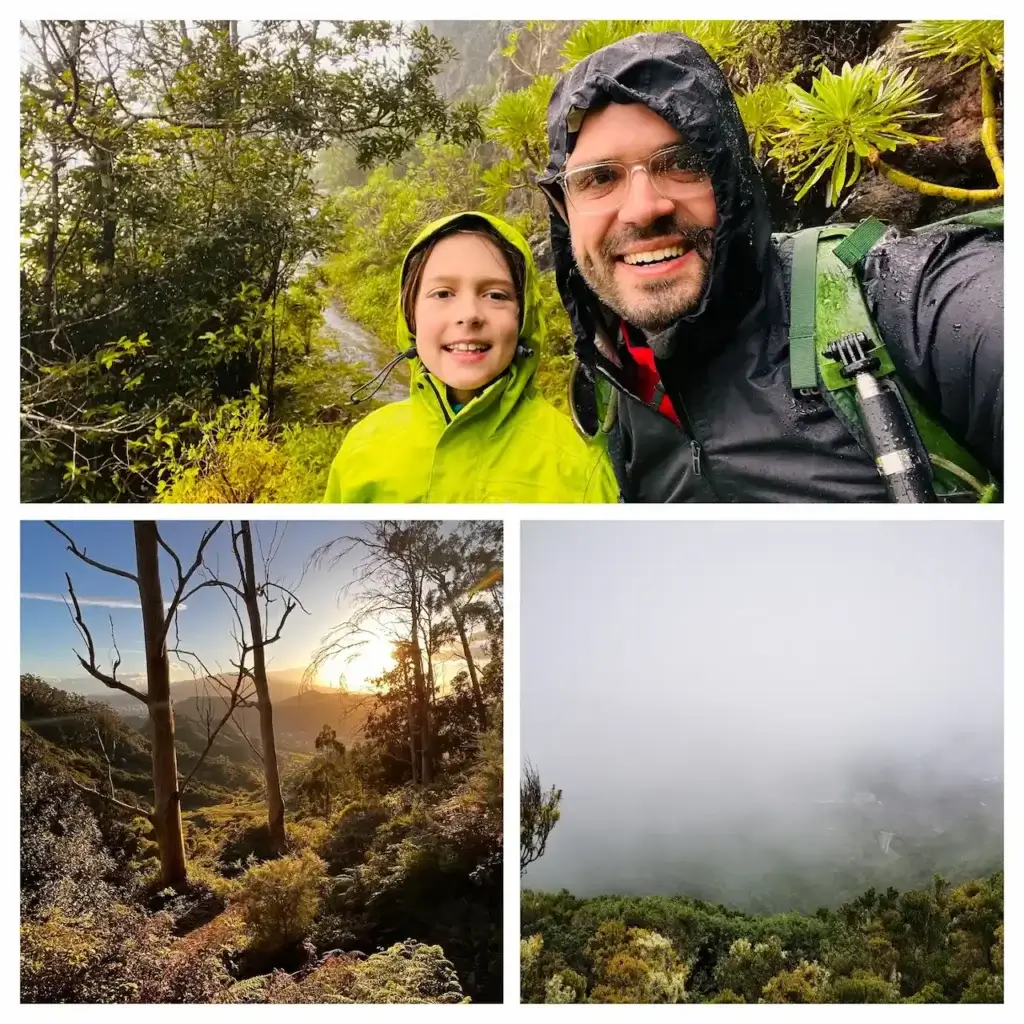
In Anaga Rural Park, the weather varies throughout the year, offering different experiences for hikers in each season.
Spring is a beautiful time to visit the park, as the temperatures are mild, ranging from 15°C to 20°C (59°F to 68°F). The chance of rain is moderate, but the lush green landscapes create nice views along the trail. As the laurel forests come to life, you’ll experience best what Anaga is famous for.
Summer in Anaga Rural Park tends to be very hot and dry, with temperatures going over 30 °C (86°F). The heat can make hiking challenging, so it’s vital to stay hydrated and protected from the sun as most of the trail goes in open terrain.
The calima, a hot and sandy wind from the Sahara desert, may occasionally affect the park, reducing visibility and increasing temperatures. Calima negatively affects people with asthma and other respiratory issues. Public authorities regularly warn of calima.
The Autumn season brings cooler temperatures, ranging from 20°C to 30°C (68°F to 86°F), while rain is still uncommon until November and December. Mild showers are possible, but most often these are a welcome respite.
Winter from December to mid-March sees temperatures ranging from 10°C to 18°C (50°F to 64°F). There can be a very high chance of rain, so come prepared with proper clothing, waterproof gear, and footwear. Despite the cooler weather, winter can be an excellent opportunity for hiking the TF-6 trail, as you’ll find fewer crowds and a serene atmosphere.
Anaga Rural Park Rules
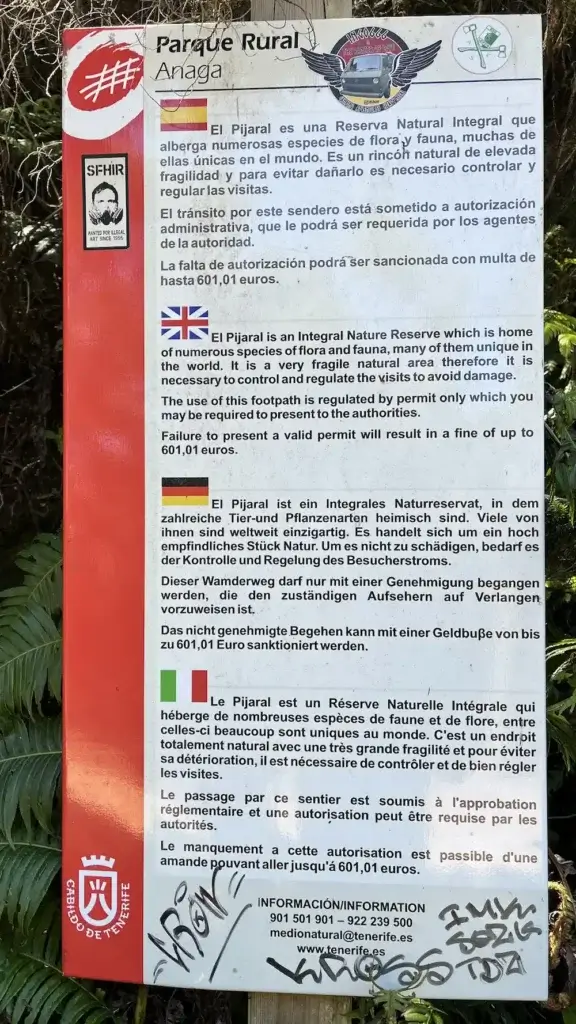
Lighting a Fire
Lighting a fire is strictly prohibited, even gas stoves.
Wild Camping
Wild camping is officially not permitted.
I’ve asked park rangers about wild camping, and the unofficial policy appears to be that as long as you clean up after yourself and leave a location as you found it, you should not run into trouble. Camping should be done only in groups of 1-2 persons.
Collecting Flora and Rocks
Preserving Anaga Rural Park’s unique biodiversity is crucial. Therefore, it is striclty prohibited to collect flora (plants, flowers, fruits, etc.) or rocks from within the park.
Border guard and customs officials regularly check for plants on the border. For example, my wife’s plants purchased and collected on the island outside protected areas were anyway confiscated by customs officials when she arrived on Spanish mainland with a ferry.
Taking Trails Without a Permit
There areas in Anaga which are strictly of limits such as the Monte Aguirre area close to Cruz del Carmen.
The only trail requiring a free permit is the Sender El Pijaral trail. If you are caught on this trail without a permit, or in any of the prohibited nature reserve areas, the fine can go up to 601.01 euros.
Where to Stay in Anaga (Recommended Hotels and Homestays)
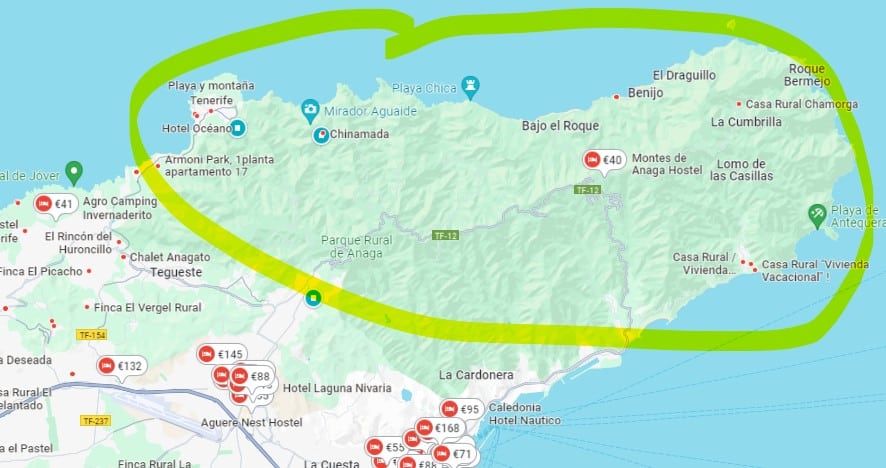
There are not very many options of staying overnight in the Anaga Rural Park itself and these are concentrated in the largest villages like Taganana, Almaciga and Benijo. I’ll add recommended options for hikers at a later date. In the meantime, search Booking.com for Anaga, read the reviews and check the accommodation’s proximity to hiking trails.
Useful Resources for Hiking in Anaga Rural Park
Tenerife Hiking Community on Facebook
We recommend joining the Tenerife Hiking Community on Facebook to connect with fellow hikers and gather useful information before embarking on your hike in Parque Rural de Anaga. This online community shares helpful tips, experiences, and suggestions from those who’ve previously explored the various trails in Tenerife and other Canary Islands.
Cruz del Carmen Tourist Information Centre
We found it very useful to visit the offical Anaga Rural Park Information Centre (Centro de Visitantes del Parque Rural de Anaga) at Cruz del Carmen close to the park border when driving from La Laguna.
The centre has English-speaking and very competent staff. You can also obtain a printed leaflet for each of the Anaga trails there (if they haven’t run out of these), as well as an excellent material about all trails on one sheet.
Visiting the centre is an excellent way to make a last check whether the information you have gathered online corresponds to reality on the ground in Tenerife.
Address: Barrio Cruz Carmen, 2, La Laguna, Santa Cruz de Tenerife, Spain (Google Maps location)
Working hours: every day from 9:30 AM to 3:00 PM.
Cruz del Carmen is the starting location of the child-friendly Path of the Senses (Sendero de los Sentidos), end-point of the TF-1 trail that comes up from the Las Mercedes village, as well as the more serious TF-10, TF-11, and TF-12 trails.
Hiking Gear Shops
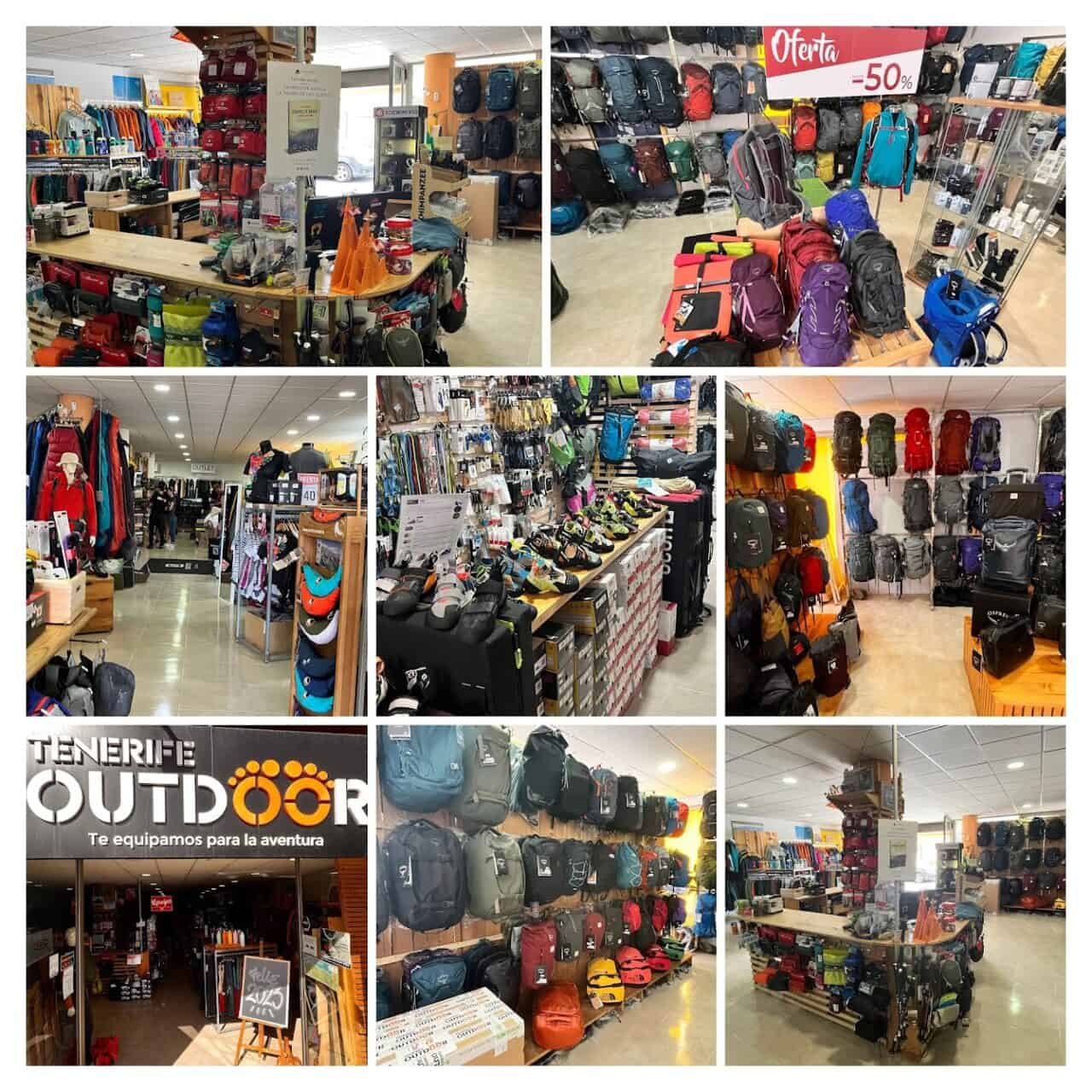
If you are missing some hiking or running equipment or are looking for a possible impulse buy, we recommend you stop by at the Tenerife Outdoor La Laguna store. This is the best hiking and camping gear shop in the North of the island, period. Below are two other recommendations you can also check out before you head out to the Anaga Rural Park.
- Tenerife Outdoor La Laguna, Av. de la República Argentina, 79, Local Bajo, 38208 La Laguna, Google Maps link. A wide selection of top brands of outdoor goods. You can also rent hiking and camping gear like walking sticks for 8 euros a day here.
- base: Deportes Salud, TF-13, 153, 38280 Tegueste, Google Maps link. The small store is more focused on regular sports, but has a decent selection of hiking shoes and walking sticks. Stop by for some good deals during sales periods. We managed to get great Salomon hiking shoes at a 50% discount.
- Decathlon La Laguna, Cam. la Hornera, 160, 38205 La Laguna, Google Maps link
— AD —
— END OF AD —
Frequently Asked Questions
No. Just wear appropriate footwear with good grip and shield yourself from the sun (and rain in winter months). Do not hike during of after strong rain and during heavy wind, as this increases the risk of falling rocks and landslides.
The best time to hike the TF-5 trail is during the spring and autumn months, when the weather is mild and pleasant. However, the trail can be hiked all year round.
A guide is not required to hike the TF-5 trail, as the trail is well-marked and easy to follow. However, if you’re inexperienced or would like a more in-depth understanding of the area and its surroundings, a guided hike might be a good option.
The TF-5 trail is a good option for inexperienced hikers. It is not as hard as the most popular TF-8 and TF-6 trails, but still gives one a nice overview of hiking in the Anaga Rural Park. Or course, this is the trail with one of the longest ridge walks in Anaga, which is a major draw of this trail.
While public transport is available in Tenerife, renting a car is a more convenient option when visiting the Anaga Rural Park. It allows you to enjoy the flexibility and freedom to explore the park at your own pace without stressing about ‘Gua Gua’ schedules. That being said, the winding roads of the Anaga Massif can be challenging for some drivers, so assess your driving skills realistically.
Yes. All Anaga Rural Park trails are dog-friendly. There are no snakes or other dangerous animals on Tenerife, so your dog can roam around quite freely. The only things you would have to watch out are the occasional dog of another hiker, and trails with steep slopes where your dog might slide or even fall off.

